Gender Inequality in the Film Industry (Hollywood)
VerifiedAdded on 2021/05/12
|21
|6263
|249
AI Summary
Stereotypes about Male dominancy and segregation do not even change in the movies; however, media is the main basis for the creation and continuation of stereotypes; that is why I thought that changing the way of representation of women in the Film industry will change the way and would be a great step towards the justice. I have chosen media and communication because of my keen interest in the film industry and culture; My project provides insights into a whole world of Feminist theory and criticism at the same time
Contribute Materials
Your contribution can guide someone’s learning journey. Share your
documents today.
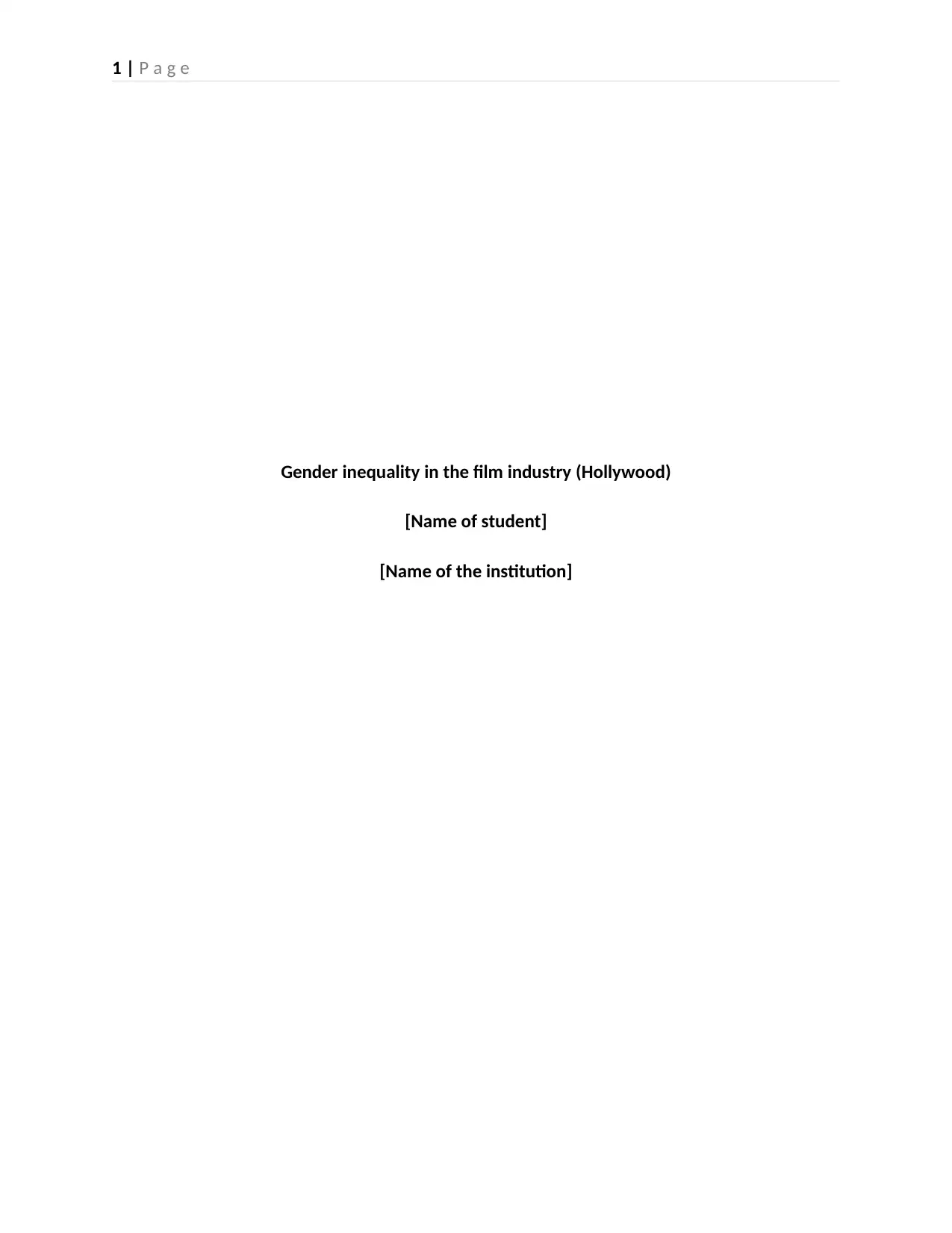
1 | P a g e
Gender inequality in the film industry (Hollywood)
[Name of student]
[Name of the institution]
Gender inequality in the film industry (Hollywood)
[Name of student]
[Name of the institution]
Secure Best Marks with AI Grader
Need help grading? Try our AI Grader for instant feedback on your assignments.
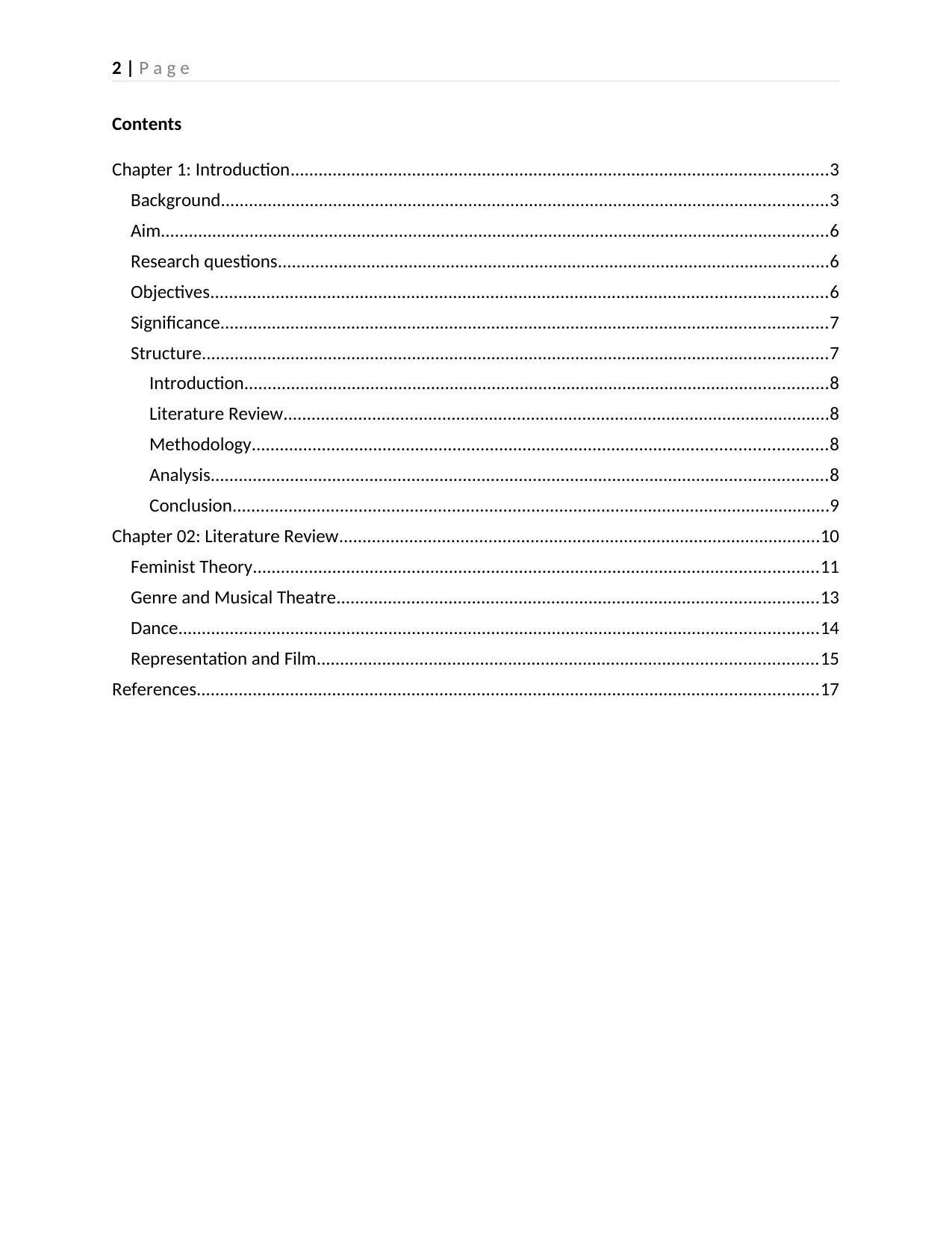
2 | P a g e
Contents
Chapter 1: Introduction...................................................................................................................3
Background..................................................................................................................................3
Aim...............................................................................................................................................6
Research questions......................................................................................................................6
Objectives....................................................................................................................................6
Significance..................................................................................................................................7
Structure......................................................................................................................................7
Introduction.............................................................................................................................8
Literature Review.....................................................................................................................8
Methodology...........................................................................................................................8
Analysis....................................................................................................................................8
Conclusion................................................................................................................................9
Chapter 02: Literature Review.......................................................................................................10
Feminist Theory.........................................................................................................................11
Genre and Musical Theatre.......................................................................................................13
Dance.........................................................................................................................................14
Representation and Film...........................................................................................................15
References.....................................................................................................................................17
Contents
Chapter 1: Introduction...................................................................................................................3
Background..................................................................................................................................3
Aim...............................................................................................................................................6
Research questions......................................................................................................................6
Objectives....................................................................................................................................6
Significance..................................................................................................................................7
Structure......................................................................................................................................7
Introduction.............................................................................................................................8
Literature Review.....................................................................................................................8
Methodology...........................................................................................................................8
Analysis....................................................................................................................................8
Conclusion................................................................................................................................9
Chapter 02: Literature Review.......................................................................................................10
Feminist Theory.........................................................................................................................11
Genre and Musical Theatre.......................................................................................................13
Dance.........................................................................................................................................14
Representation and Film...........................................................................................................15
References.....................................................................................................................................17
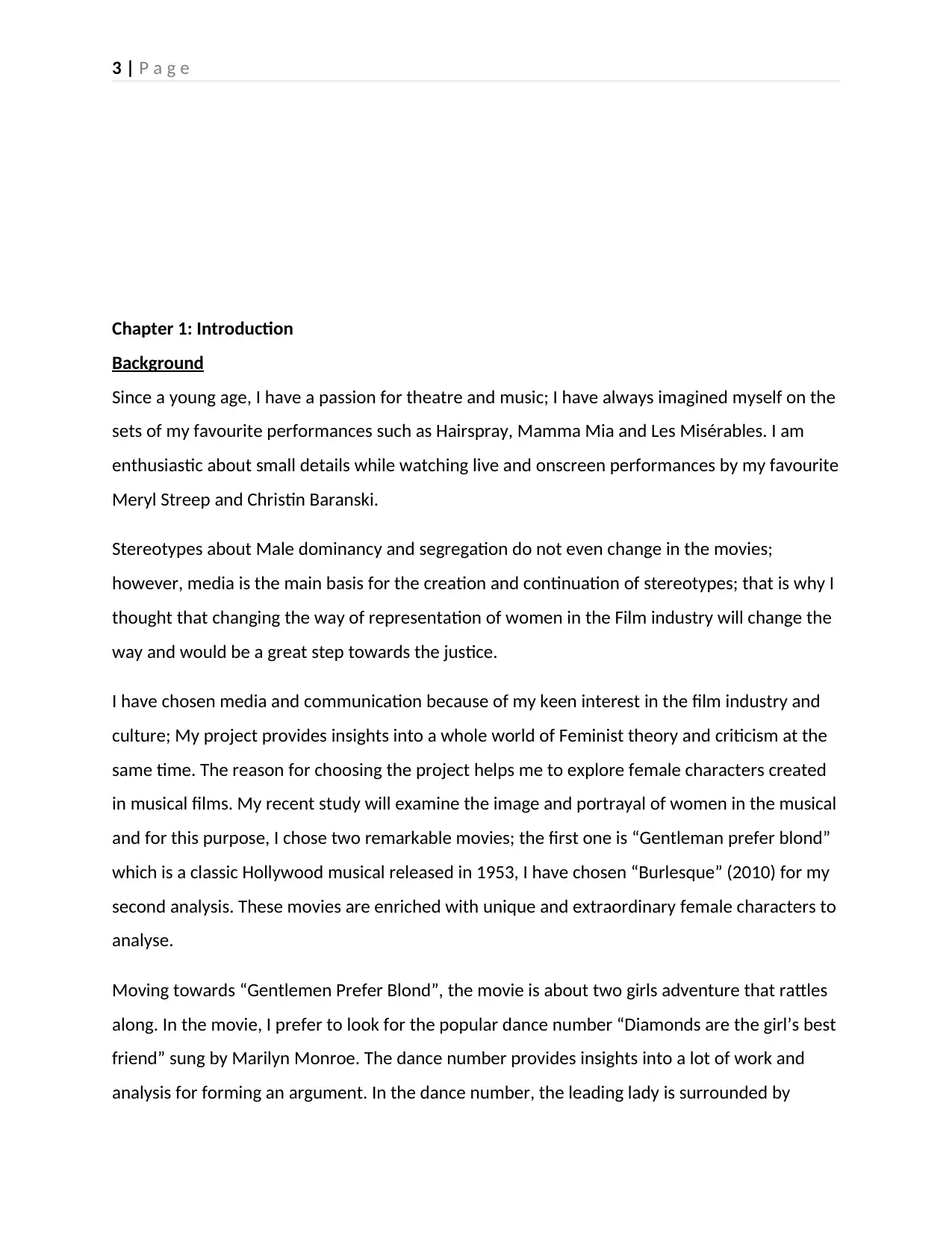
3 | P a g e
Chapter 1: Introduction
Background
Since a young age, I have a passion for theatre and music; I have always imagined myself on the
sets of my favourite performances such as Hairspray, Mamma Mia and Les Misérables. I am
enthusiastic about small details while watching live and onscreen performances by my favourite
Meryl Streep and Christin Baranski.
Stereotypes about Male dominancy and segregation do not even change in the movies;
however, media is the main basis for the creation and continuation of stereotypes; that is why I
thought that changing the way of representation of women in the Film industry will change the
way and would be a great step towards the justice.
I have chosen media and communication because of my keen interest in the film industry and
culture; My project provides insights into a whole world of Feminist theory and criticism at the
same time. The reason for choosing the project helps me to explore female characters created
in musical films. My recent study will examine the image and portrayal of women in the musical
and for this purpose, I chose two remarkable movies; the first one is “Gentleman prefer blond”
which is a classic Hollywood musical released in 1953, I have chosen “Burlesque” (2010) for my
second analysis. These movies are enriched with unique and extraordinary female characters to
analyse.
Moving towards “Gentlemen Prefer Blond”, the movie is about two girls adventure that rattles
along. In the movie, I prefer to look for the popular dance number “Diamonds are the girl’s best
friend” sung by Marilyn Monroe. The dance number provides insights into a lot of work and
analysis for forming an argument. In the dance number, the leading lady is surrounded by
Chapter 1: Introduction
Background
Since a young age, I have a passion for theatre and music; I have always imagined myself on the
sets of my favourite performances such as Hairspray, Mamma Mia and Les Misérables. I am
enthusiastic about small details while watching live and onscreen performances by my favourite
Meryl Streep and Christin Baranski.
Stereotypes about Male dominancy and segregation do not even change in the movies;
however, media is the main basis for the creation and continuation of stereotypes; that is why I
thought that changing the way of representation of women in the Film industry will change the
way and would be a great step towards the justice.
I have chosen media and communication because of my keen interest in the film industry and
culture; My project provides insights into a whole world of Feminist theory and criticism at the
same time. The reason for choosing the project helps me to explore female characters created
in musical films. My recent study will examine the image and portrayal of women in the musical
and for this purpose, I chose two remarkable movies; the first one is “Gentleman prefer blond”
which is a classic Hollywood musical released in 1953, I have chosen “Burlesque” (2010) for my
second analysis. These movies are enriched with unique and extraordinary female characters to
analyse.
Moving towards “Gentlemen Prefer Blond”, the movie is about two girls adventure that rattles
along. In the movie, I prefer to look for the popular dance number “Diamonds are the girl’s best
friend” sung by Marilyn Monroe. The dance number provides insights into a lot of work and
analysis for forming an argument. In the dance number, the leading lady is surrounded by
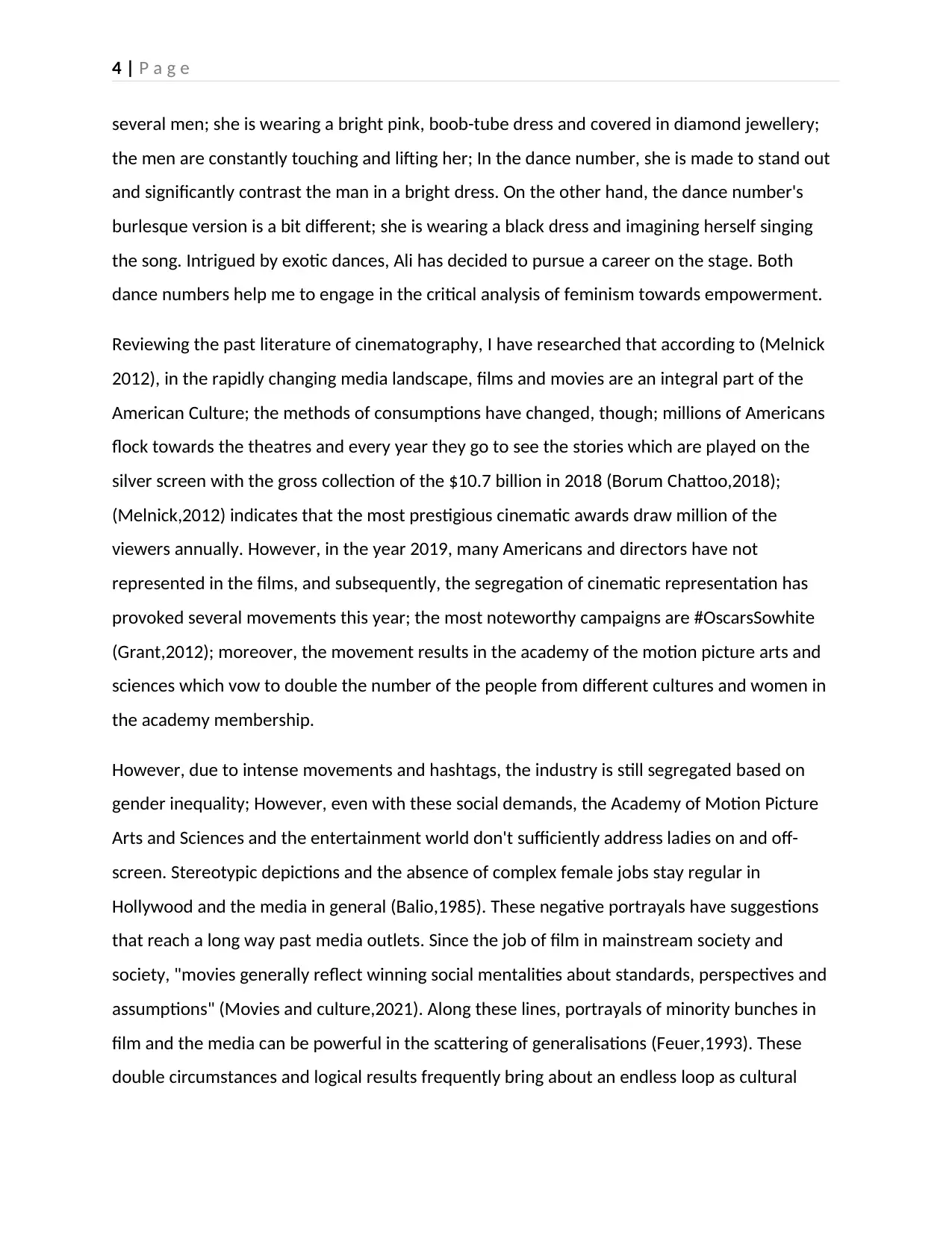
4 | P a g e
several men; she is wearing a bright pink, boob-tube dress and covered in diamond jewellery;
the men are constantly touching and lifting her; In the dance number, she is made to stand out
and significantly contrast the man in a bright dress. On the other hand, the dance number's
burlesque version is a bit different; she is wearing a black dress and imagining herself singing
the song. Intrigued by exotic dances, Ali has decided to pursue a career on the stage. Both
dance numbers help me to engage in the critical analysis of feminism towards empowerment.
Reviewing the past literature of cinematography, I have researched that according to (Melnick
2012), in the rapidly changing media landscape, films and movies are an integral part of the
American Culture; the methods of consumptions have changed, though; millions of Americans
flock towards the theatres and every year they go to see the stories which are played on the
silver screen with the gross collection of the $10.7 billion in 2018 (Borum Chattoo,2018);
(Melnick,2012) indicates that the most prestigious cinematic awards draw million of the
viewers annually. However, in the year 2019, many Americans and directors have not
represented in the films, and subsequently, the segregation of cinematic representation has
provoked several movements this year; the most noteworthy campaigns are #OscarsSowhite
(Grant,2012); moreover, the movement results in the academy of the motion picture arts and
sciences which vow to double the number of the people from different cultures and women in
the academy membership.
However, due to intense movements and hashtags, the industry is still segregated based on
gender inequality; However, even with these social demands, the Academy of Motion Picture
Arts and Sciences and the entertainment world don't sufficiently address ladies on and off-
screen. Stereotypic depictions and the absence of complex female jobs stay regular in
Hollywood and the media in general (Balio,1985). These negative portrayals have suggestions
that reach a long way past media outlets. Since the job of film in mainstream society and
society, "movies generally reflect winning social mentalities about standards, perspectives and
assumptions" (Movies and culture,2021). Along these lines, portrayals of minority bunches in
film and the media can be powerful in the scattering of generalisations (Feuer,1993). These
double circumstances and logical results frequently bring about an endless loop as cultural
several men; she is wearing a bright pink, boob-tube dress and covered in diamond jewellery;
the men are constantly touching and lifting her; In the dance number, she is made to stand out
and significantly contrast the man in a bright dress. On the other hand, the dance number's
burlesque version is a bit different; she is wearing a black dress and imagining herself singing
the song. Intrigued by exotic dances, Ali has decided to pursue a career on the stage. Both
dance numbers help me to engage in the critical analysis of feminism towards empowerment.
Reviewing the past literature of cinematography, I have researched that according to (Melnick
2012), in the rapidly changing media landscape, films and movies are an integral part of the
American Culture; the methods of consumptions have changed, though; millions of Americans
flock towards the theatres and every year they go to see the stories which are played on the
silver screen with the gross collection of the $10.7 billion in 2018 (Borum Chattoo,2018);
(Melnick,2012) indicates that the most prestigious cinematic awards draw million of the
viewers annually. However, in the year 2019, many Americans and directors have not
represented in the films, and subsequently, the segregation of cinematic representation has
provoked several movements this year; the most noteworthy campaigns are #OscarsSowhite
(Grant,2012); moreover, the movement results in the academy of the motion picture arts and
sciences which vow to double the number of the people from different cultures and women in
the academy membership.
However, due to intense movements and hashtags, the industry is still segregated based on
gender inequality; However, even with these social demands, the Academy of Motion Picture
Arts and Sciences and the entertainment world don't sufficiently address ladies on and off-
screen. Stereotypic depictions and the absence of complex female jobs stay regular in
Hollywood and the media in general (Balio,1985). These negative portrayals have suggestions
that reach a long way past media outlets. Since the job of film in mainstream society and
society, "movies generally reflect winning social mentalities about standards, perspectives and
assumptions" (Movies and culture,2021). Along these lines, portrayals of minority bunches in
film and the media can be powerful in the scattering of generalisations (Feuer,1993). These
double circumstances and logical results frequently bring about an endless loop as cultural
Secure Best Marks with AI Grader
Need help grading? Try our AI Grader for instant feedback on your assignments.
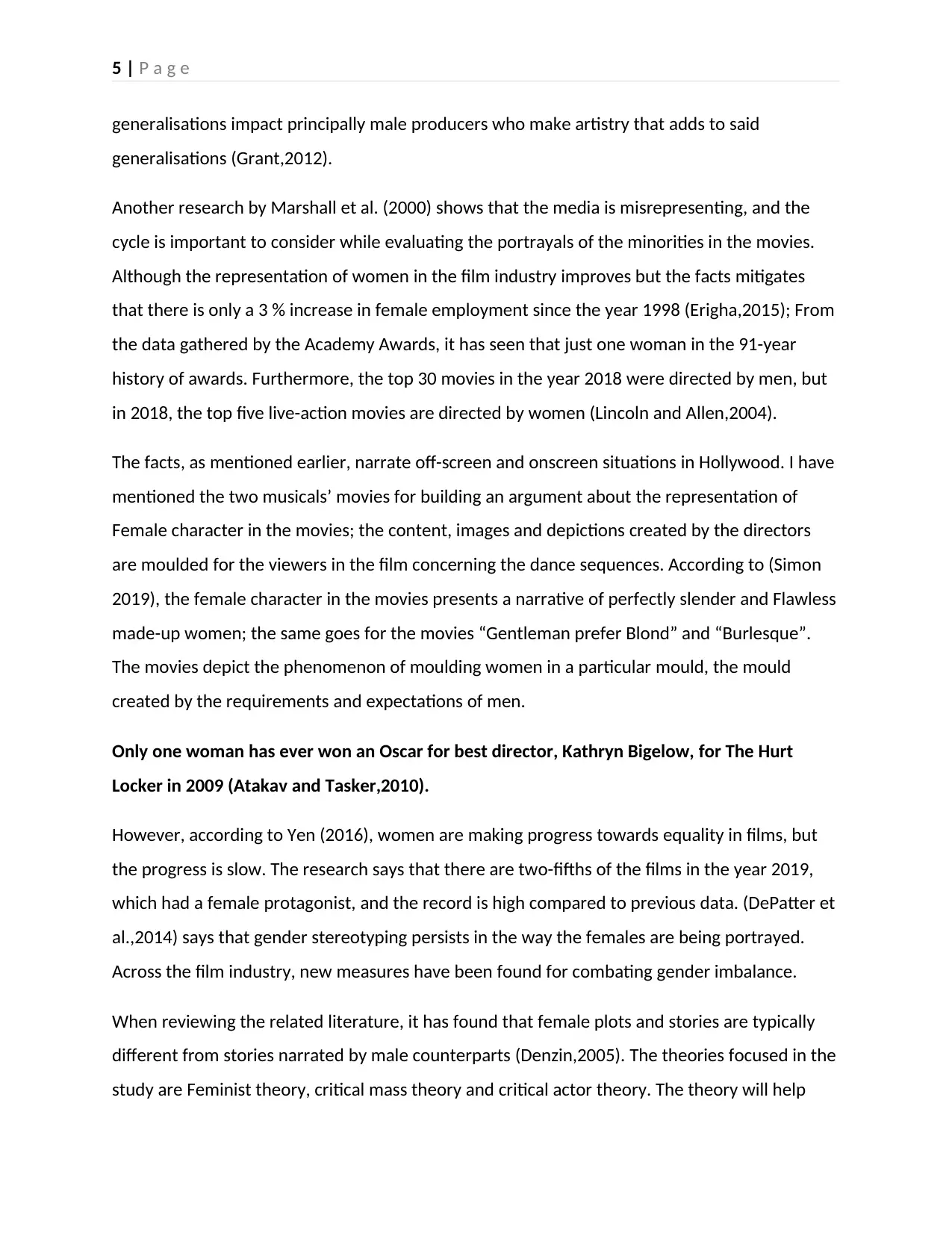
5 | P a g e
generalisations impact principally male producers who make artistry that adds to said
generalisations (Grant,2012).
Another research by Marshall et al. (2000) shows that the media is misrepresenting, and the
cycle is important to consider while evaluating the portrayals of the minorities in the movies.
Although the representation of women in the film industry improves but the facts mitigates
that there is only a 3 % increase in female employment since the year 1998 (Erigha,2015); From
the data gathered by the Academy Awards, it has seen that just one woman in the 91-year
history of awards. Furthermore, the top 30 movies in the year 2018 were directed by men, but
in 2018, the top five live-action movies are directed by women (Lincoln and Allen,2004).
The facts, as mentioned earlier, narrate off-screen and onscreen situations in Hollywood. I have
mentioned the two musicals’ movies for building an argument about the representation of
Female character in the movies; the content, images and depictions created by the directors
are moulded for the viewers in the film concerning the dance sequences. According to (Simon
2019), the female character in the movies presents a narrative of perfectly slender and Flawless
made-up women; the same goes for the movies “Gentleman prefer Blond” and “Burlesque”.
The movies depict the phenomenon of moulding women in a particular mould, the mould
created by the requirements and expectations of men.
Only one woman has ever won an Oscar for best director, Kathryn Bigelow, for The Hurt
Locker in 2009 (Atakav and Tasker,2010).
However, according to Yen (2016), women are making progress towards equality in films, but
the progress is slow. The research says that there are two-fifths of the films in the year 2019,
which had a female protagonist, and the record is high compared to previous data. (DePatter et
al.,2014) says that gender stereotyping persists in the way the females are being portrayed.
Across the film industry, new measures have been found for combating gender imbalance.
When reviewing the related literature, it has found that female plots and stories are typically
different from stories narrated by male counterparts (Denzin,2005). The theories focused in the
study are Feminist theory, critical mass theory and critical actor theory. The theory will help
generalisations impact principally male producers who make artistry that adds to said
generalisations (Grant,2012).
Another research by Marshall et al. (2000) shows that the media is misrepresenting, and the
cycle is important to consider while evaluating the portrayals of the minorities in the movies.
Although the representation of women in the film industry improves but the facts mitigates
that there is only a 3 % increase in female employment since the year 1998 (Erigha,2015); From
the data gathered by the Academy Awards, it has seen that just one woman in the 91-year
history of awards. Furthermore, the top 30 movies in the year 2018 were directed by men, but
in 2018, the top five live-action movies are directed by women (Lincoln and Allen,2004).
The facts, as mentioned earlier, narrate off-screen and onscreen situations in Hollywood. I have
mentioned the two musicals’ movies for building an argument about the representation of
Female character in the movies; the content, images and depictions created by the directors
are moulded for the viewers in the film concerning the dance sequences. According to (Simon
2019), the female character in the movies presents a narrative of perfectly slender and Flawless
made-up women; the same goes for the movies “Gentleman prefer Blond” and “Burlesque”.
The movies depict the phenomenon of moulding women in a particular mould, the mould
created by the requirements and expectations of men.
Only one woman has ever won an Oscar for best director, Kathryn Bigelow, for The Hurt
Locker in 2009 (Atakav and Tasker,2010).
However, according to Yen (2016), women are making progress towards equality in films, but
the progress is slow. The research says that there are two-fifths of the films in the year 2019,
which had a female protagonist, and the record is high compared to previous data. (DePatter et
al.,2014) says that gender stereotyping persists in the way the females are being portrayed.
Across the film industry, new measures have been found for combating gender imbalance.
When reviewing the related literature, it has found that female plots and stories are typically
different from stories narrated by male counterparts (Denzin,2005). The theories focused in the
study are Feminist theory, critical mass theory and critical actor theory. The theory will help
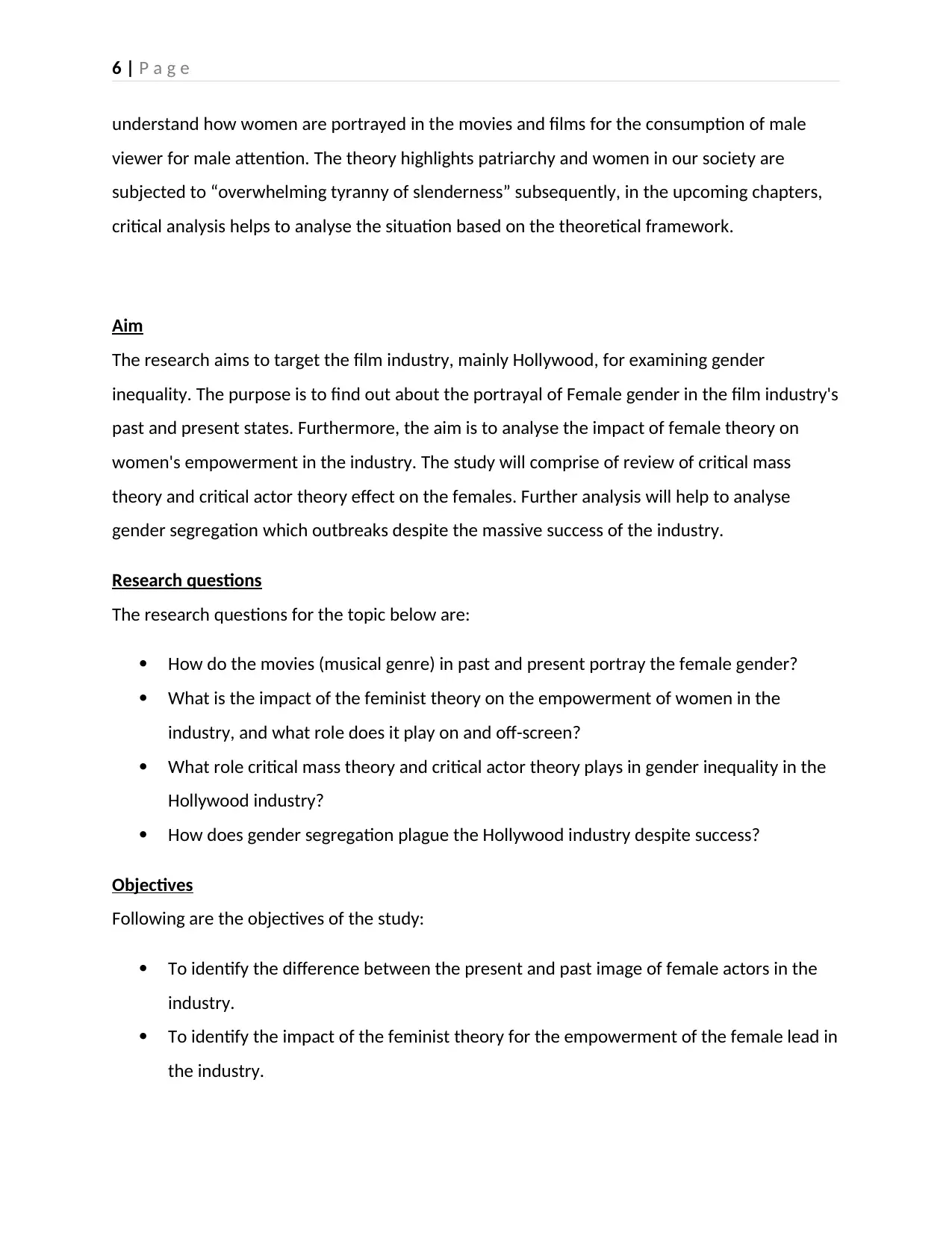
6 | P a g e
understand how women are portrayed in the movies and films for the consumption of male
viewer for male attention. The theory highlights patriarchy and women in our society are
subjected to “overwhelming tyranny of slenderness” subsequently, in the upcoming chapters,
critical analysis helps to analyse the situation based on the theoretical framework.
Aim
The research aims to target the film industry, mainly Hollywood, for examining gender
inequality. The purpose is to find out about the portrayal of Female gender in the film industry's
past and present states. Furthermore, the aim is to analyse the impact of female theory on
women's empowerment in the industry. The study will comprise of review of critical mass
theory and critical actor theory effect on the females. Further analysis will help to analyse
gender segregation which outbreaks despite the massive success of the industry.
Research questions
The research questions for the topic below are:
How do the movies (musical genre) in past and present portray the female gender?
What is the impact of the feminist theory on the empowerment of women in the
industry, and what role does it play on and off-screen?
What role critical mass theory and critical actor theory plays in gender inequality in the
Hollywood industry?
How does gender segregation plague the Hollywood industry despite success?
Objectives
Following are the objectives of the study:
To identify the difference between the present and past image of female actors in the
industry.
To identify the impact of the feminist theory for the empowerment of the female lead in
the industry.
understand how women are portrayed in the movies and films for the consumption of male
viewer for male attention. The theory highlights patriarchy and women in our society are
subjected to “overwhelming tyranny of slenderness” subsequently, in the upcoming chapters,
critical analysis helps to analyse the situation based on the theoretical framework.
Aim
The research aims to target the film industry, mainly Hollywood, for examining gender
inequality. The purpose is to find out about the portrayal of Female gender in the film industry's
past and present states. Furthermore, the aim is to analyse the impact of female theory on
women's empowerment in the industry. The study will comprise of review of critical mass
theory and critical actor theory effect on the females. Further analysis will help to analyse
gender segregation which outbreaks despite the massive success of the industry.
Research questions
The research questions for the topic below are:
How do the movies (musical genre) in past and present portray the female gender?
What is the impact of the feminist theory on the empowerment of women in the
industry, and what role does it play on and off-screen?
What role critical mass theory and critical actor theory plays in gender inequality in the
Hollywood industry?
How does gender segregation plague the Hollywood industry despite success?
Objectives
Following are the objectives of the study:
To identify the difference between the present and past image of female actors in the
industry.
To identify the impact of the feminist theory for the empowerment of the female lead in
the industry.
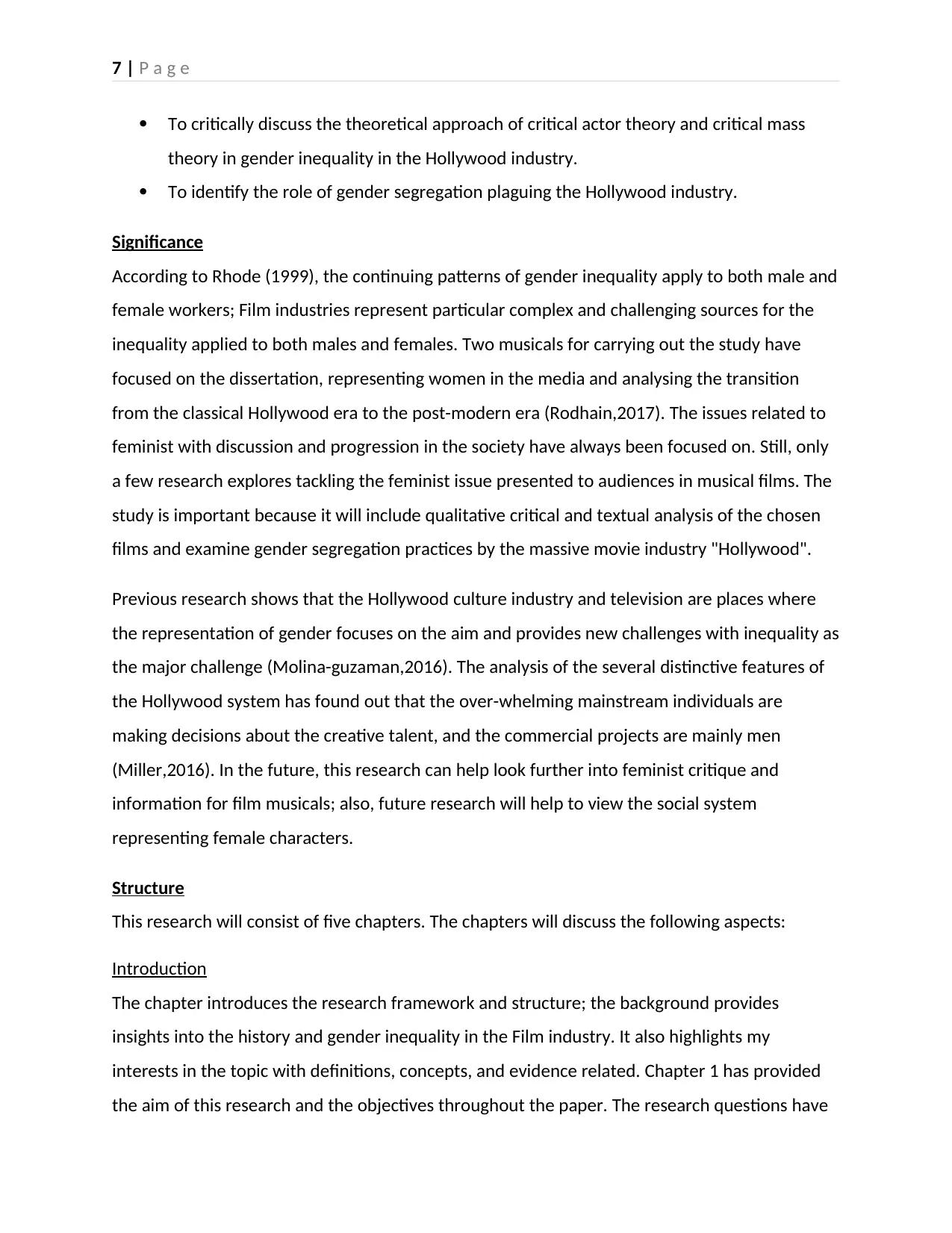
7 | P a g e
To critically discuss the theoretical approach of critical actor theory and critical mass
theory in gender inequality in the Hollywood industry.
To identify the role of gender segregation plaguing the Hollywood industry.
Significance
According to Rhode (1999), the continuing patterns of gender inequality apply to both male and
female workers; Film industries represent particular complex and challenging sources for the
inequality applied to both males and females. Two musicals for carrying out the study have
focused on the dissertation, representing women in the media and analysing the transition
from the classical Hollywood era to the post-modern era (Rodhain,2017). The issues related to
feminist with discussion and progression in the society have always been focused on. Still, only
a few research explores tackling the feminist issue presented to audiences in musical films. The
study is important because it will include qualitative critical and textual analysis of the chosen
films and examine gender segregation practices by the massive movie industry "Hollywood".
Previous research shows that the Hollywood culture industry and television are places where
the representation of gender focuses on the aim and provides new challenges with inequality as
the major challenge (Molina-guzaman,2016). The analysis of the several distinctive features of
the Hollywood system has found out that the over-whelming mainstream individuals are
making decisions about the creative talent, and the commercial projects are mainly men
(Miller,2016). In the future, this research can help look further into feminist critique and
information for film musicals; also, future research will help to view the social system
representing female characters.
Structure
This research will consist of five chapters. The chapters will discuss the following aspects:
Introduction
The chapter introduces the research framework and structure; the background provides
insights into the history and gender inequality in the Film industry. It also highlights my
interests in the topic with definitions, concepts, and evidence related. Chapter 1 has provided
the aim of this research and the objectives throughout the paper. The research questions have
To critically discuss the theoretical approach of critical actor theory and critical mass
theory in gender inequality in the Hollywood industry.
To identify the role of gender segregation plaguing the Hollywood industry.
Significance
According to Rhode (1999), the continuing patterns of gender inequality apply to both male and
female workers; Film industries represent particular complex and challenging sources for the
inequality applied to both males and females. Two musicals for carrying out the study have
focused on the dissertation, representing women in the media and analysing the transition
from the classical Hollywood era to the post-modern era (Rodhain,2017). The issues related to
feminist with discussion and progression in the society have always been focused on. Still, only
a few research explores tackling the feminist issue presented to audiences in musical films. The
study is important because it will include qualitative critical and textual analysis of the chosen
films and examine gender segregation practices by the massive movie industry "Hollywood".
Previous research shows that the Hollywood culture industry and television are places where
the representation of gender focuses on the aim and provides new challenges with inequality as
the major challenge (Molina-guzaman,2016). The analysis of the several distinctive features of
the Hollywood system has found out that the over-whelming mainstream individuals are
making decisions about the creative talent, and the commercial projects are mainly men
(Miller,2016). In the future, this research can help look further into feminist critique and
information for film musicals; also, future research will help to view the social system
representing female characters.
Structure
This research will consist of five chapters. The chapters will discuss the following aspects:
Introduction
The chapter introduces the research framework and structure; the background provides
insights into the history and gender inequality in the Film industry. It also highlights my
interests in the topic with definitions, concepts, and evidence related. Chapter 1 has provided
the aim of this research and the objectives throughout the paper. The research questions have
Paraphrase This Document
Need a fresh take? Get an instant paraphrase of this document with our AI Paraphraser
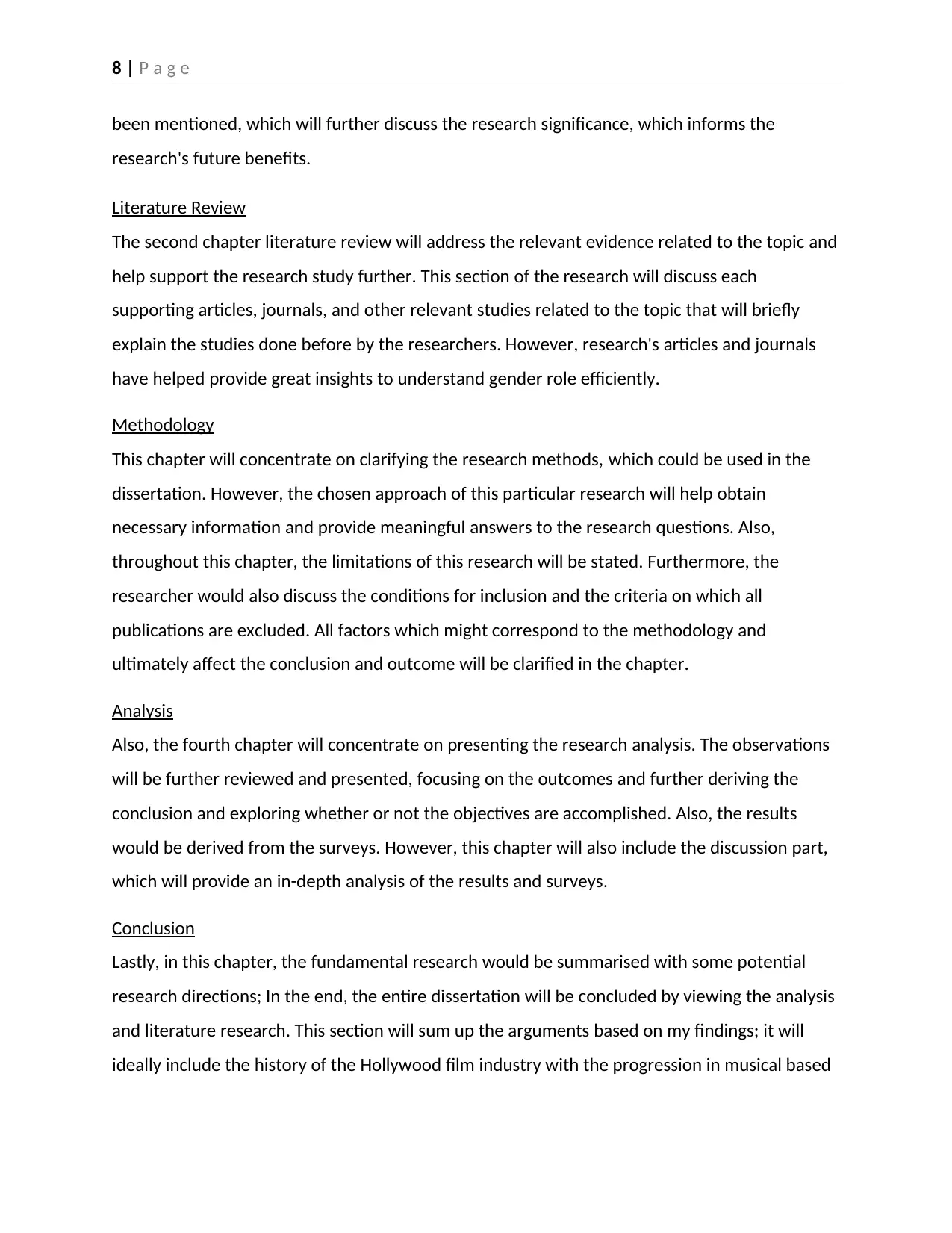
8 | P a g e
been mentioned, which will further discuss the research significance, which informs the
research's future benefits.
Literature Review
The second chapter literature review will address the relevant evidence related to the topic and
help support the research study further. This section of the research will discuss each
supporting articles, journals, and other relevant studies related to the topic that will briefly
explain the studies done before by the researchers. However, research's articles and journals
have helped provide great insights to understand gender role efficiently.
Methodology
This chapter will concentrate on clarifying the research methods, which could be used in the
dissertation. However, the chosen approach of this particular research will help obtain
necessary information and provide meaningful answers to the research questions. Also,
throughout this chapter, the limitations of this research will be stated. Furthermore, the
researcher would also discuss the conditions for inclusion and the criteria on which all
publications are excluded. All factors which might correspond to the methodology and
ultimately affect the conclusion and outcome will be clarified in the chapter.
Analysis
Also, the fourth chapter will concentrate on presenting the research analysis. The observations
will be further reviewed and presented, focusing on the outcomes and further deriving the
conclusion and exploring whether or not the objectives are accomplished. Also, the results
would be derived from the surveys. However, this chapter will also include the discussion part,
which will provide an in-depth analysis of the results and surveys.
Conclusion
Lastly, in this chapter, the fundamental research would be summarised with some potential
research directions; In the end, the entire dissertation will be concluded by viewing the analysis
and literature research. This section will sum up the arguments based on my findings; it will
ideally include the history of the Hollywood film industry with the progression in musical based
been mentioned, which will further discuss the research significance, which informs the
research's future benefits.
Literature Review
The second chapter literature review will address the relevant evidence related to the topic and
help support the research study further. This section of the research will discuss each
supporting articles, journals, and other relevant studies related to the topic that will briefly
explain the studies done before by the researchers. However, research's articles and journals
have helped provide great insights to understand gender role efficiently.
Methodology
This chapter will concentrate on clarifying the research methods, which could be used in the
dissertation. However, the chosen approach of this particular research will help obtain
necessary information and provide meaningful answers to the research questions. Also,
throughout this chapter, the limitations of this research will be stated. Furthermore, the
researcher would also discuss the conditions for inclusion and the criteria on which all
publications are excluded. All factors which might correspond to the methodology and
ultimately affect the conclusion and outcome will be clarified in the chapter.
Analysis
Also, the fourth chapter will concentrate on presenting the research analysis. The observations
will be further reviewed and presented, focusing on the outcomes and further deriving the
conclusion and exploring whether or not the objectives are accomplished. Also, the results
would be derived from the surveys. However, this chapter will also include the discussion part,
which will provide an in-depth analysis of the results and surveys.
Conclusion
Lastly, in this chapter, the fundamental research would be summarised with some potential
research directions; In the end, the entire dissertation will be concluded by viewing the analysis
and literature research. This section will sum up the arguments based on my findings; it will
ideally include the history of the Hollywood film industry with the progression in musical based
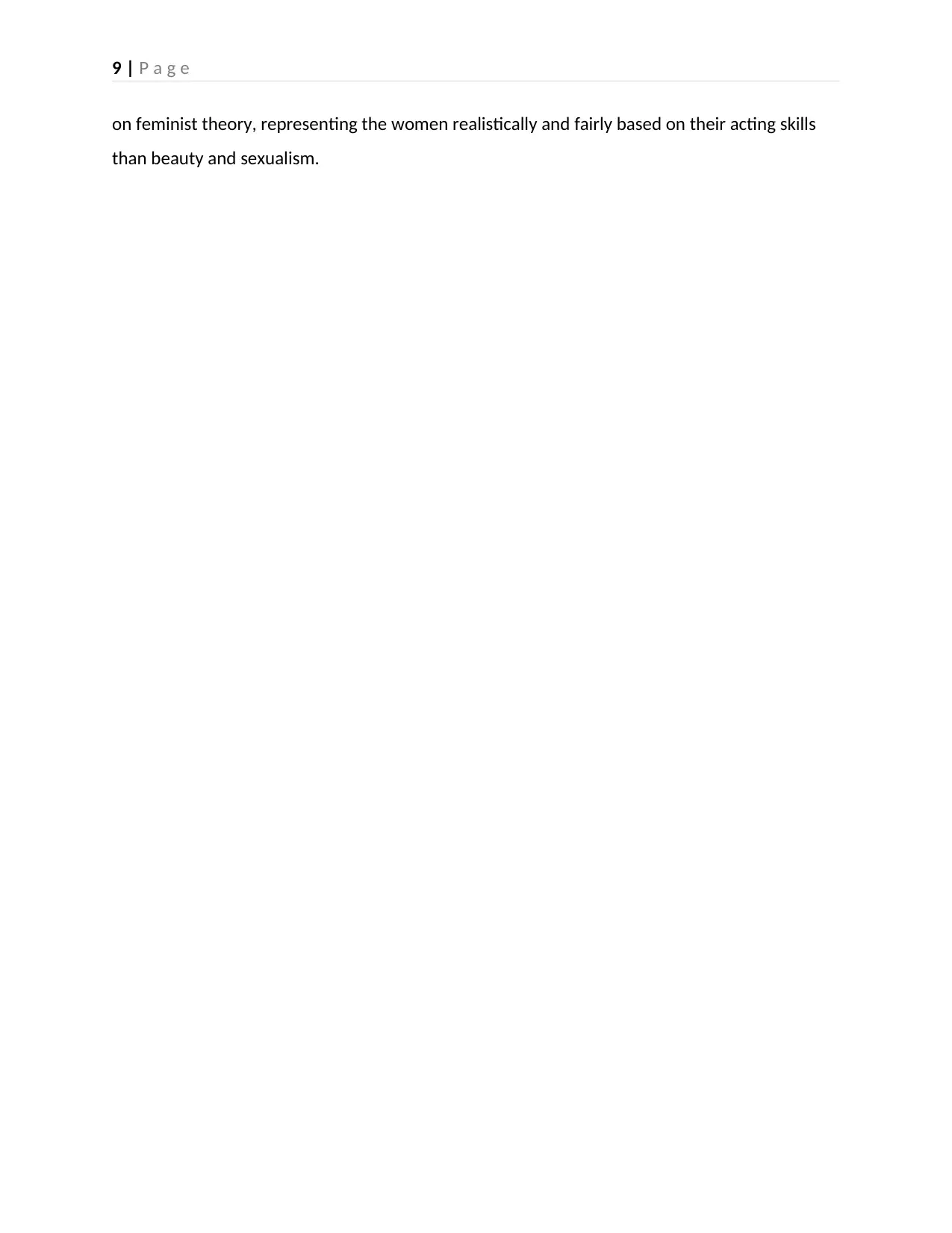
9 | P a g e
on feminist theory, representing the women realistically and fairly based on their acting skills
than beauty and sexualism.
on feminist theory, representing the women realistically and fairly based on their acting skills
than beauty and sexualism.
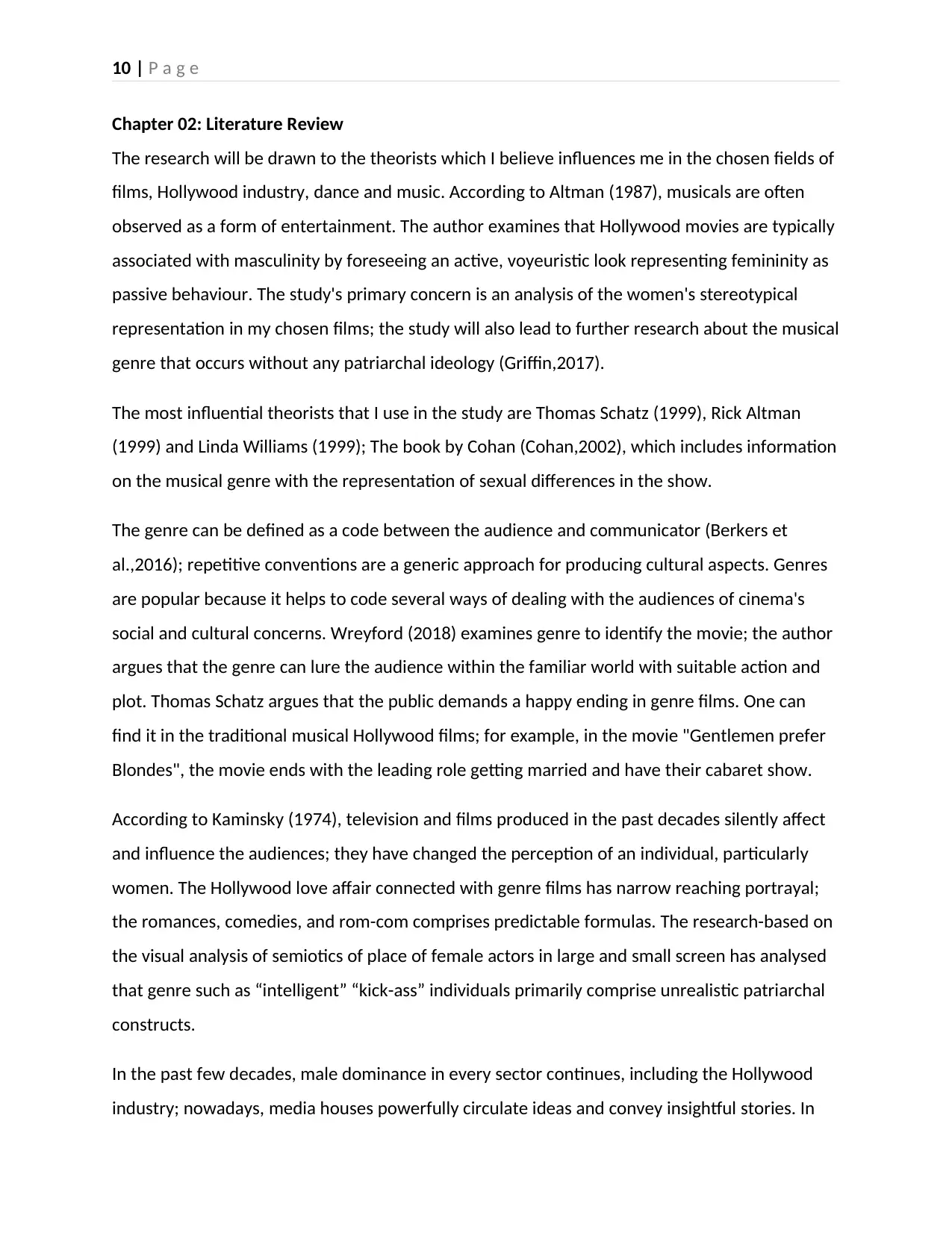
10 | P a g e
Chapter 02: Literature Review
The research will be drawn to the theorists which I believe influences me in the chosen fields of
films, Hollywood industry, dance and music. According to Altman (1987), musicals are often
observed as a form of entertainment. The author examines that Hollywood movies are typically
associated with masculinity by foreseeing an active, voyeuristic look representing femininity as
passive behaviour. The study's primary concern is an analysis of the women's stereotypical
representation in my chosen films; the study will also lead to further research about the musical
genre that occurs without any patriarchal ideology (Griffin,2017).
The most influential theorists that I use in the study are Thomas Schatz (1999), Rick Altman
(1999) and Linda Williams (1999); The book by Cohan (Cohan,2002), which includes information
on the musical genre with the representation of sexual differences in the show.
The genre can be defined as a code between the audience and communicator (Berkers et
al.,2016); repetitive conventions are a generic approach for producing cultural aspects. Genres
are popular because it helps to code several ways of dealing with the audiences of cinema's
social and cultural concerns. Wreyford (2018) examines genre to identify the movie; the author
argues that the genre can lure the audience within the familiar world with suitable action and
plot. Thomas Schatz argues that the public demands a happy ending in genre films. One can
find it in the traditional musical Hollywood films; for example, in the movie "Gentlemen prefer
Blondes", the movie ends with the leading role getting married and have their cabaret show.
According to Kaminsky (1974), television and films produced in the past decades silently affect
and influence the audiences; they have changed the perception of an individual, particularly
women. The Hollywood love affair connected with genre films has narrow reaching portrayal;
the romances, comedies, and rom-com comprises predictable formulas. The research-based on
the visual analysis of semiotics of place of female actors in large and small screen has analysed
that genre such as “intelligent” “kick-ass” individuals primarily comprise unrealistic patriarchal
constructs.
In the past few decades, male dominance in every sector continues, including the Hollywood
industry; nowadays, media houses powerfully circulate ideas and convey insightful stories. In
Chapter 02: Literature Review
The research will be drawn to the theorists which I believe influences me in the chosen fields of
films, Hollywood industry, dance and music. According to Altman (1987), musicals are often
observed as a form of entertainment. The author examines that Hollywood movies are typically
associated with masculinity by foreseeing an active, voyeuristic look representing femininity as
passive behaviour. The study's primary concern is an analysis of the women's stereotypical
representation in my chosen films; the study will also lead to further research about the musical
genre that occurs without any patriarchal ideology (Griffin,2017).
The most influential theorists that I use in the study are Thomas Schatz (1999), Rick Altman
(1999) and Linda Williams (1999); The book by Cohan (Cohan,2002), which includes information
on the musical genre with the representation of sexual differences in the show.
The genre can be defined as a code between the audience and communicator (Berkers et
al.,2016); repetitive conventions are a generic approach for producing cultural aspects. Genres
are popular because it helps to code several ways of dealing with the audiences of cinema's
social and cultural concerns. Wreyford (2018) examines genre to identify the movie; the author
argues that the genre can lure the audience within the familiar world with suitable action and
plot. Thomas Schatz argues that the public demands a happy ending in genre films. One can
find it in the traditional musical Hollywood films; for example, in the movie "Gentlemen prefer
Blondes", the movie ends with the leading role getting married and have their cabaret show.
According to Kaminsky (1974), television and films produced in the past decades silently affect
and influence the audiences; they have changed the perception of an individual, particularly
women. The Hollywood love affair connected with genre films has narrow reaching portrayal;
the romances, comedies, and rom-com comprises predictable formulas. The research-based on
the visual analysis of semiotics of place of female actors in large and small screen has analysed
that genre such as “intelligent” “kick-ass” individuals primarily comprise unrealistic patriarchal
constructs.
In the past few decades, male dominance in every sector continues, including the Hollywood
industry; nowadays, media houses powerfully circulate ideas and convey insightful stories. In
Secure Best Marks with AI Grader
Need help grading? Try our AI Grader for instant feedback on your assignments.
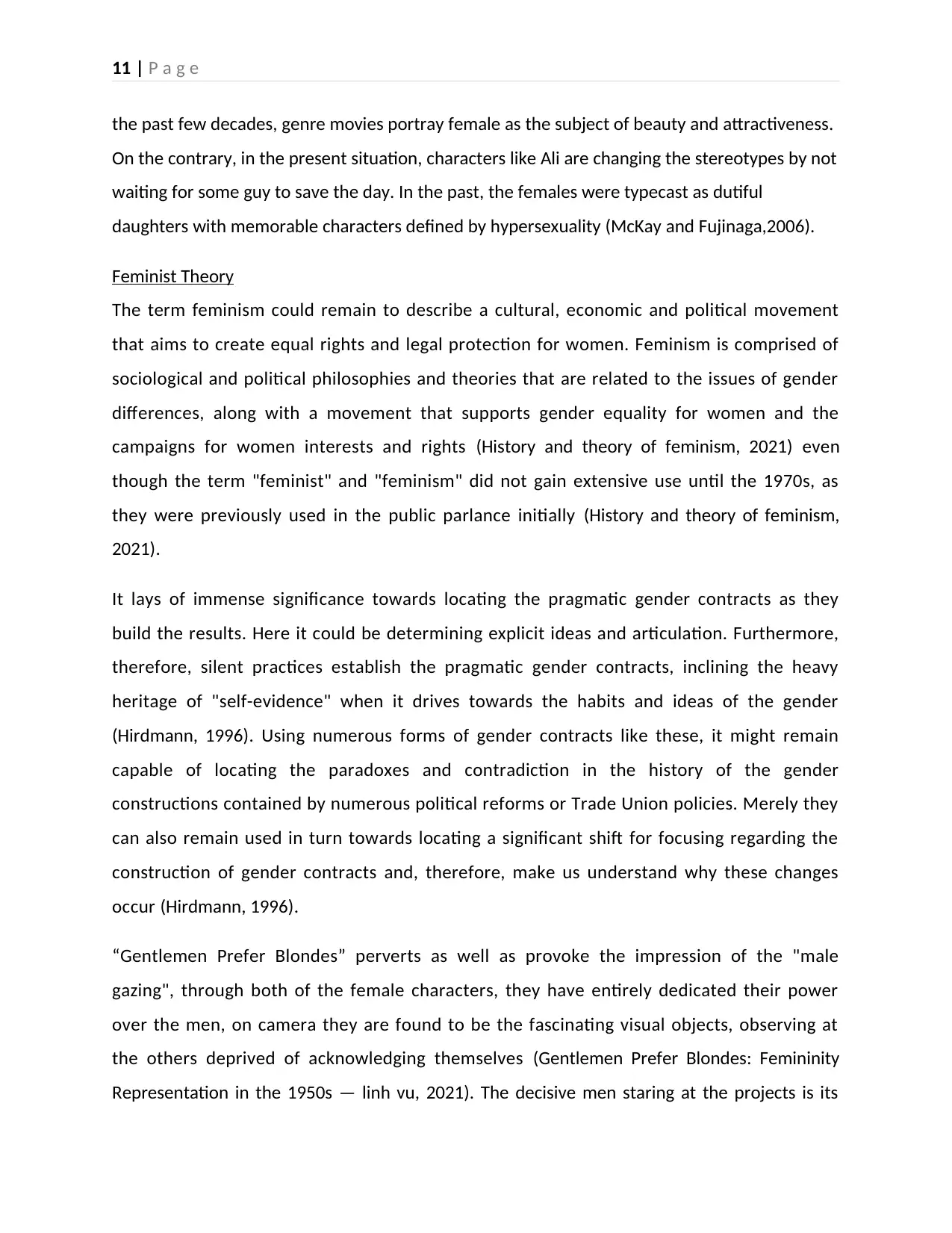
11 | P a g e
the past few decades, genre movies portray female as the subject of beauty and attractiveness.
On the contrary, in the present situation, characters like Ali are changing the stereotypes by not
waiting for some guy to save the day. In the past, the females were typecast as dutiful
daughters with memorable characters defined by hypersexuality (McKay and Fujinaga,2006).
Feminist Theory
The term feminism could remain to describe a cultural, economic and political movement
that aims to create equal rights and legal protection for women. Feminism is comprised of
sociological and political philosophies and theories that are related to the issues of gender
differences, along with a movement that supports gender equality for women and the
campaigns for women interests and rights (History and theory of feminism, 2021) even
though the term "feminist" and "feminism" did not gain extensive use until the 1970s, as
they were previously used in the public parlance initially (History and theory of feminism,
2021).
It lays of immense significance towards locating the pragmatic gender contracts as they
build the results. Here it could be determining explicit ideas and articulation. Furthermore,
therefore, silent practices establish the pragmatic gender contracts, inclining the heavy
heritage of "self-evidence" when it drives towards the habits and ideas of the gender
(Hirdmann, 1996). Using numerous forms of gender contracts like these, it might remain
capable of locating the paradoxes and contradiction in the history of the gender
constructions contained by numerous political reforms or Trade Union policies. Merely they
can also remain used in turn towards locating a significant shift for focusing regarding the
construction of gender contracts and, therefore, make us understand why these changes
occur (Hirdmann, 1996).
“Gentlemen Prefer Blondes” perverts as well as provoke the impression of the "male
gazing", through both of the female characters, they have entirely dedicated their power
over the men, on camera they are found to be the fascinating visual objects, observing at
the others deprived of acknowledging themselves (Gentlemen Prefer Blondes: Femininity
Representation in the 1950s — linh vu, 2021). The decisive men staring at the projects is its
the past few decades, genre movies portray female as the subject of beauty and attractiveness.
On the contrary, in the present situation, characters like Ali are changing the stereotypes by not
waiting for some guy to save the day. In the past, the females were typecast as dutiful
daughters with memorable characters defined by hypersexuality (McKay and Fujinaga,2006).
Feminist Theory
The term feminism could remain to describe a cultural, economic and political movement
that aims to create equal rights and legal protection for women. Feminism is comprised of
sociological and political philosophies and theories that are related to the issues of gender
differences, along with a movement that supports gender equality for women and the
campaigns for women interests and rights (History and theory of feminism, 2021) even
though the term "feminist" and "feminism" did not gain extensive use until the 1970s, as
they were previously used in the public parlance initially (History and theory of feminism,
2021).
It lays of immense significance towards locating the pragmatic gender contracts as they
build the results. Here it could be determining explicit ideas and articulation. Furthermore,
therefore, silent practices establish the pragmatic gender contracts, inclining the heavy
heritage of "self-evidence" when it drives towards the habits and ideas of the gender
(Hirdmann, 1996). Using numerous forms of gender contracts like these, it might remain
capable of locating the paradoxes and contradiction in the history of the gender
constructions contained by numerous political reforms or Trade Union policies. Merely they
can also remain used in turn towards locating a significant shift for focusing regarding the
construction of gender contracts and, therefore, make us understand why these changes
occur (Hirdmann, 1996).
“Gentlemen Prefer Blondes” perverts as well as provoke the impression of the "male
gazing", through both of the female characters, they have entirely dedicated their power
over the men, on camera they are found to be the fascinating visual objects, observing at
the others deprived of acknowledging themselves (Gentlemen Prefer Blondes: Femininity
Representation in the 1950s — linh vu, 2021). The decisive men staring at the projects is its
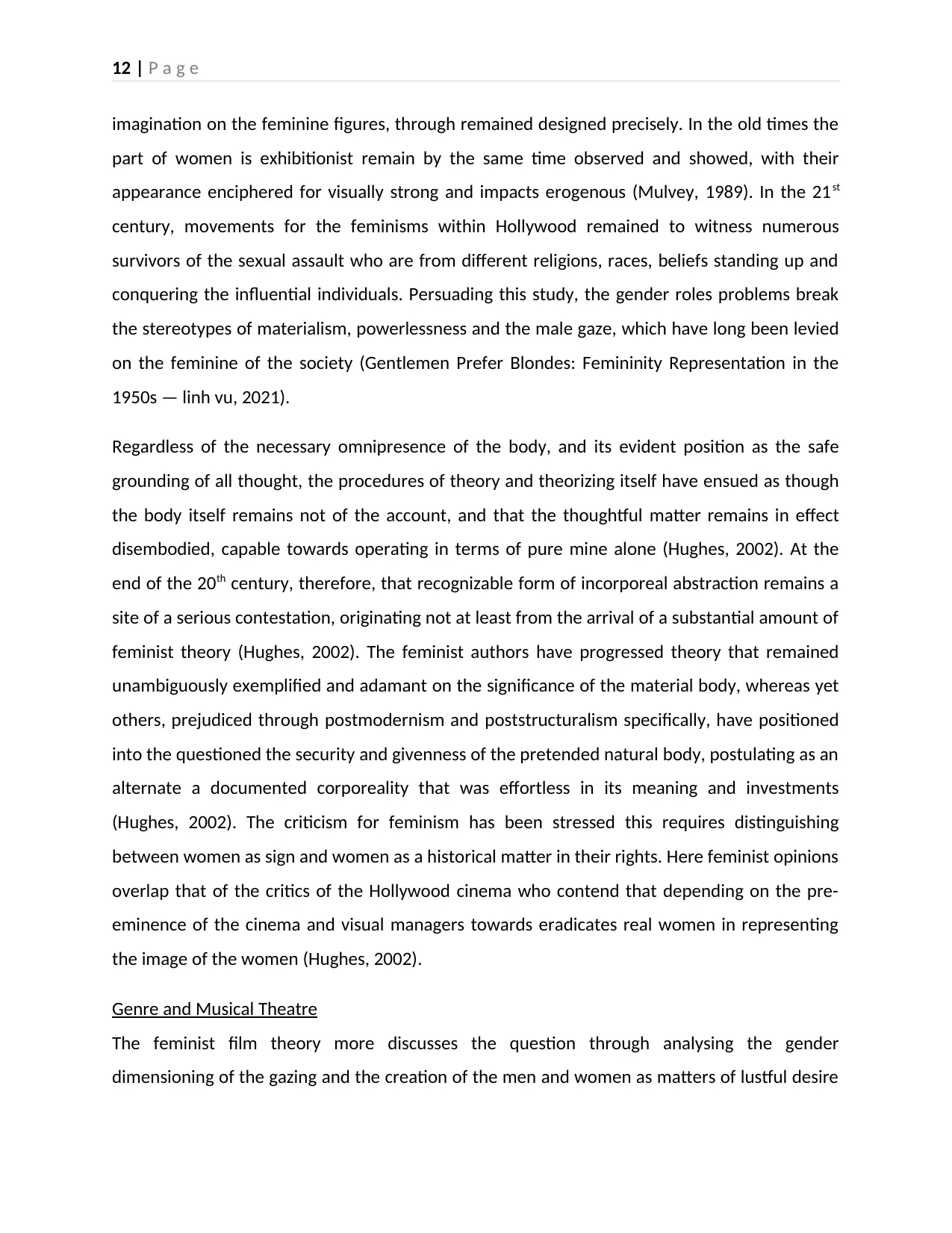
12 | P a g e
imagination on the feminine figures, through remained designed precisely. In the old times the
part of women is exhibitionist remain by the same time observed and showed, with their
appearance enciphered for visually strong and impacts erogenous (Mulvey, 1989). In the 21st
century, movements for the feminisms within Hollywood remained to witness numerous
survivors of the sexual assault who are from different religions, races, beliefs standing up and
conquering the influential individuals. Persuading this study, the gender roles problems break
the stereotypes of materialism, powerlessness and the male gaze, which have long been levied
on the feminine of the society (Gentlemen Prefer Blondes: Femininity Representation in the
1950s — linh vu, 2021).
Regardless of the necessary omnipresence of the body, and its evident position as the safe
grounding of all thought, the procedures of theory and theorizing itself have ensued as though
the body itself remains not of the account, and that the thoughtful matter remains in effect
disembodied, capable towards operating in terms of pure mine alone (Hughes, 2002). At the
end of the 20th century, therefore, that recognizable form of incorporeal abstraction remains a
site of a serious contestation, originating not at least from the arrival of a substantial amount of
feminist theory (Hughes, 2002). The feminist authors have progressed theory that remained
unambiguously exemplified and adamant on the significance of the material body, whereas yet
others, prejudiced through postmodernism and poststructuralism specifically, have positioned
into the questioned the security and givenness of the pretended natural body, postulating as an
alternate a documented corporeality that was effortless in its meaning and investments
(Hughes, 2002). The criticism for feminism has been stressed this requires distinguishing
between women as sign and women as a historical matter in their rights. Here feminist opinions
overlap that of the critics of the Hollywood cinema who contend that depending on the pre-
eminence of the cinema and visual managers towards eradicates real women in representing
the image of the women (Hughes, 2002).
Genre and Musical Theatre
The feminist film theory more discusses the question through analysing the gender
dimensioning of the gazing and the creation of the men and women as matters of lustful desire
imagination on the feminine figures, through remained designed precisely. In the old times the
part of women is exhibitionist remain by the same time observed and showed, with their
appearance enciphered for visually strong and impacts erogenous (Mulvey, 1989). In the 21st
century, movements for the feminisms within Hollywood remained to witness numerous
survivors of the sexual assault who are from different religions, races, beliefs standing up and
conquering the influential individuals. Persuading this study, the gender roles problems break
the stereotypes of materialism, powerlessness and the male gaze, which have long been levied
on the feminine of the society (Gentlemen Prefer Blondes: Femininity Representation in the
1950s — linh vu, 2021).
Regardless of the necessary omnipresence of the body, and its evident position as the safe
grounding of all thought, the procedures of theory and theorizing itself have ensued as though
the body itself remains not of the account, and that the thoughtful matter remains in effect
disembodied, capable towards operating in terms of pure mine alone (Hughes, 2002). At the
end of the 20th century, therefore, that recognizable form of incorporeal abstraction remains a
site of a serious contestation, originating not at least from the arrival of a substantial amount of
feminist theory (Hughes, 2002). The feminist authors have progressed theory that remained
unambiguously exemplified and adamant on the significance of the material body, whereas yet
others, prejudiced through postmodernism and poststructuralism specifically, have positioned
into the questioned the security and givenness of the pretended natural body, postulating as an
alternate a documented corporeality that was effortless in its meaning and investments
(Hughes, 2002). The criticism for feminism has been stressed this requires distinguishing
between women as sign and women as a historical matter in their rights. Here feminist opinions
overlap that of the critics of the Hollywood cinema who contend that depending on the pre-
eminence of the cinema and visual managers towards eradicates real women in representing
the image of the women (Hughes, 2002).
Genre and Musical Theatre
The feminist film theory more discusses the question through analysing the gender
dimensioning of the gazing and the creation of the men and women as matters of lustful desire
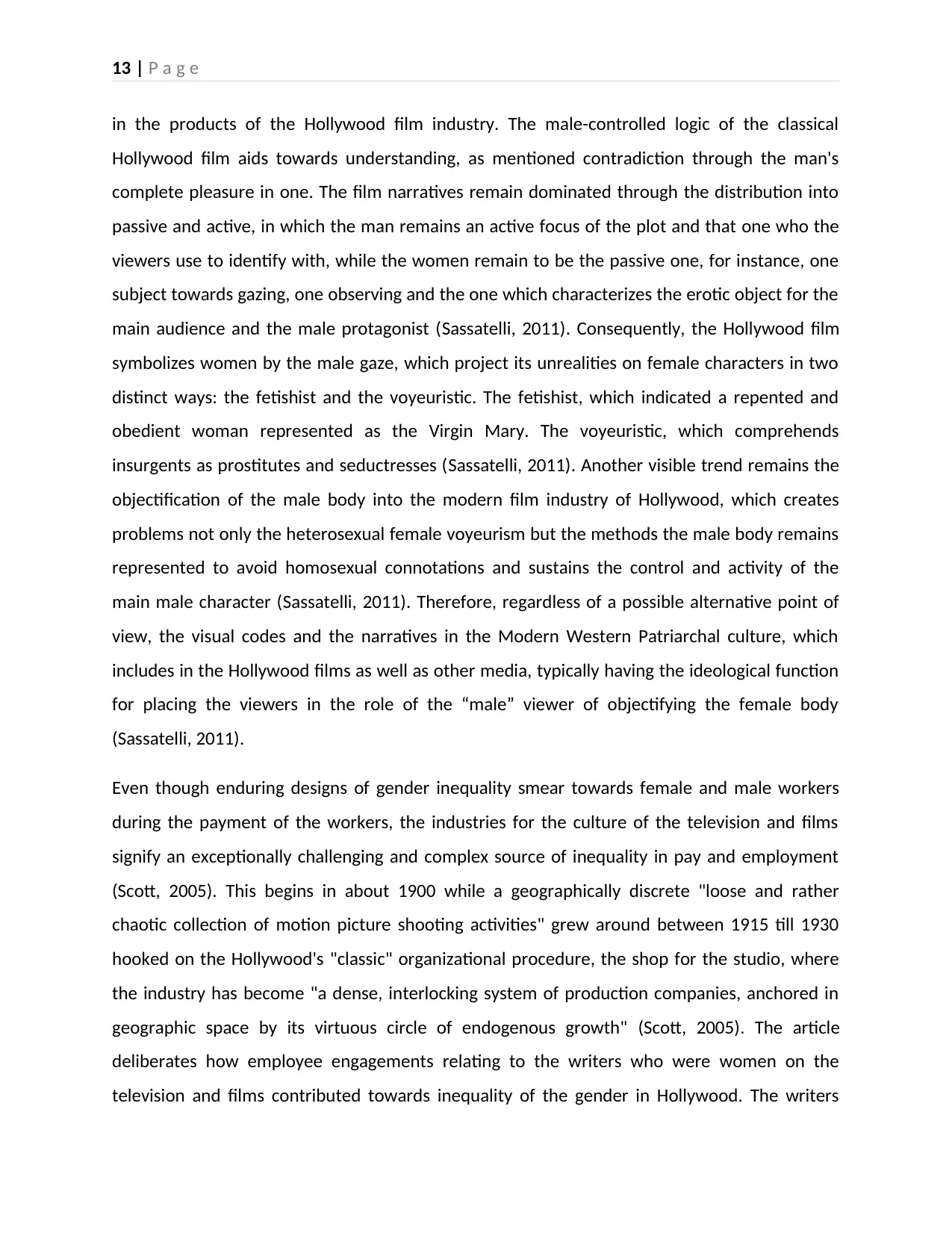
13 | P a g e
in the products of the Hollywood film industry. The male-controlled logic of the classical
Hollywood film aids towards understanding, as mentioned contradiction through the man's
complete pleasure in one. The film narratives remain dominated through the distribution into
passive and active, in which the man remains an active focus of the plot and that one who the
viewers use to identify with, while the women remain to be the passive one, for instance, one
subject towards gazing, one observing and the one which characterizes the erotic object for the
main audience and the male protagonist (Sassatelli, 2011). Consequently, the Hollywood film
symbolizes women by the male gaze, which project its unrealities on female characters in two
distinct ways: the fetishist and the voyeuristic. The fetishist, which indicated a repented and
obedient woman represented as the Virgin Mary. The voyeuristic, which comprehends
insurgents as prostitutes and seductresses (Sassatelli, 2011). Another visible trend remains the
objectification of the male body into the modern film industry of Hollywood, which creates
problems not only the heterosexual female voyeurism but the methods the male body remains
represented to avoid homosexual connotations and sustains the control and activity of the
main male character (Sassatelli, 2011). Therefore, regardless of a possible alternative point of
view, the visual codes and the narratives in the Modern Western Patriarchal culture, which
includes in the Hollywood films as well as other media, typically having the ideological function
for placing the viewers in the role of the “male” viewer of objectifying the female body
(Sassatelli, 2011).
Even though enduring designs of gender inequality smear towards female and male workers
during the payment of the workers, the industries for the culture of the television and films
signify an exceptionally challenging and complex source of inequality in pay and employment
(Scott, 2005). This begins in about 1900 while a geographically discrete "loose and rather
chaotic collection of motion picture shooting activities" grew around between 1915 till 1930
hooked on the Hollywood's "classic" organizational procedure, the shop for the studio, where
the industry has become "a dense, interlocking system of production companies, anchored in
geographic space by its virtuous circle of endogenous growth" (Scott, 2005). The article
deliberates how employee engagements relating to the writers who were women on the
television and films contributed towards inequality of the gender in Hollywood. The writers
in the products of the Hollywood film industry. The male-controlled logic of the classical
Hollywood film aids towards understanding, as mentioned contradiction through the man's
complete pleasure in one. The film narratives remain dominated through the distribution into
passive and active, in which the man remains an active focus of the plot and that one who the
viewers use to identify with, while the women remain to be the passive one, for instance, one
subject towards gazing, one observing and the one which characterizes the erotic object for the
main audience and the male protagonist (Sassatelli, 2011). Consequently, the Hollywood film
symbolizes women by the male gaze, which project its unrealities on female characters in two
distinct ways: the fetishist and the voyeuristic. The fetishist, which indicated a repented and
obedient woman represented as the Virgin Mary. The voyeuristic, which comprehends
insurgents as prostitutes and seductresses (Sassatelli, 2011). Another visible trend remains the
objectification of the male body into the modern film industry of Hollywood, which creates
problems not only the heterosexual female voyeurism but the methods the male body remains
represented to avoid homosexual connotations and sustains the control and activity of the
main male character (Sassatelli, 2011). Therefore, regardless of a possible alternative point of
view, the visual codes and the narratives in the Modern Western Patriarchal culture, which
includes in the Hollywood films as well as other media, typically having the ideological function
for placing the viewers in the role of the “male” viewer of objectifying the female body
(Sassatelli, 2011).
Even though enduring designs of gender inequality smear towards female and male workers
during the payment of the workers, the industries for the culture of the television and films
signify an exceptionally challenging and complex source of inequality in pay and employment
(Scott, 2005). This begins in about 1900 while a geographically discrete "loose and rather
chaotic collection of motion picture shooting activities" grew around between 1915 till 1930
hooked on the Hollywood's "classic" organizational procedure, the shop for the studio, where
the industry has become "a dense, interlocking system of production companies, anchored in
geographic space by its virtuous circle of endogenous growth" (Scott, 2005). The article
deliberates how employee engagements relating to the writers who were women on the
television and films contributed towards inequality of the gender in Hollywood. The writers
Paraphrase This Document
Need a fresh take? Get an instant paraphrase of this document with our AI Paraphraser
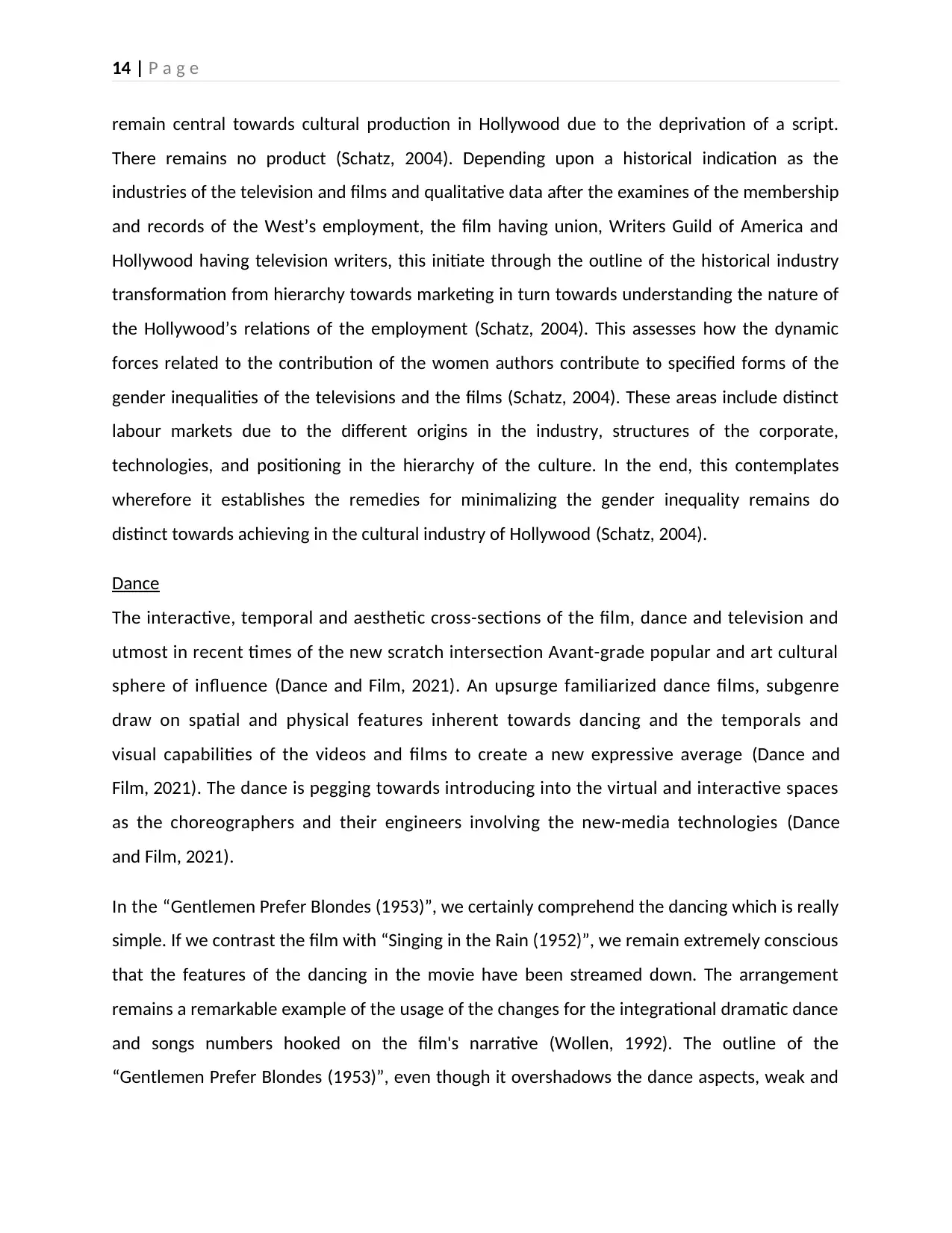
14 | P a g e
remain central towards cultural production in Hollywood due to the deprivation of a script.
There remains no product (Schatz, 2004). Depending upon a historical indication as the
industries of the television and films and qualitative data after the examines of the membership
and records of the West’s employment, the film having union, Writers Guild of America and
Hollywood having television writers, this initiate through the outline of the historical industry
transformation from hierarchy towards marketing in turn towards understanding the nature of
the Hollywood’s relations of the employment (Schatz, 2004). This assesses how the dynamic
forces related to the contribution of the women authors contribute to specified forms of the
gender inequalities of the televisions and the films (Schatz, 2004). These areas include distinct
labour markets due to the different origins in the industry, structures of the corporate,
technologies, and positioning in the hierarchy of the culture. In the end, this contemplates
wherefore it establishes the remedies for minimalizing the gender inequality remains do
distinct towards achieving in the cultural industry of Hollywood (Schatz, 2004).
Dance
The interactive, temporal and aesthetic cross-sections of the film, dance and television and
utmost in recent times of the new scratch intersection Avant-grade popular and art cultural
sphere of influence (Dance and Film, 2021). An upsurge familiarized dance films, subgenre
draw on spatial and physical features inherent towards dancing and the temporals and
visual capabilities of the videos and films to create a new expressive average (Dance and
Film, 2021). The dance is pegging towards introducing into the virtual and interactive spaces
as the choreographers and their engineers involving the new-media technologies (Dance
and Film, 2021).
In the “Gentlemen Prefer Blondes (1953)”, we certainly comprehend the dancing which is really
simple. If we contrast the film with “Singing in the Rain (1952)”, we remain extremely conscious
that the features of the dancing in the movie have been streamed down. The arrangement
remains a remarkable example of the usage of the changes for the integrational dramatic dance
and songs numbers hooked on the film's narrative (Wollen, 1992). The outline of the
“Gentlemen Prefer Blondes (1953)”, even though it overshadows the dance aspects, weak and
remain central towards cultural production in Hollywood due to the deprivation of a script.
There remains no product (Schatz, 2004). Depending upon a historical indication as the
industries of the television and films and qualitative data after the examines of the membership
and records of the West’s employment, the film having union, Writers Guild of America and
Hollywood having television writers, this initiate through the outline of the historical industry
transformation from hierarchy towards marketing in turn towards understanding the nature of
the Hollywood’s relations of the employment (Schatz, 2004). This assesses how the dynamic
forces related to the contribution of the women authors contribute to specified forms of the
gender inequalities of the televisions and the films (Schatz, 2004). These areas include distinct
labour markets due to the different origins in the industry, structures of the corporate,
technologies, and positioning in the hierarchy of the culture. In the end, this contemplates
wherefore it establishes the remedies for minimalizing the gender inequality remains do
distinct towards achieving in the cultural industry of Hollywood (Schatz, 2004).
Dance
The interactive, temporal and aesthetic cross-sections of the film, dance and television and
utmost in recent times of the new scratch intersection Avant-grade popular and art cultural
sphere of influence (Dance and Film, 2021). An upsurge familiarized dance films, subgenre
draw on spatial and physical features inherent towards dancing and the temporals and
visual capabilities of the videos and films to create a new expressive average (Dance and
Film, 2021). The dance is pegging towards introducing into the virtual and interactive spaces
as the choreographers and their engineers involving the new-media technologies (Dance
and Film, 2021).
In the “Gentlemen Prefer Blondes (1953)”, we certainly comprehend the dancing which is really
simple. If we contrast the film with “Singing in the Rain (1952)”, we remain extremely conscious
that the features of the dancing in the movie have been streamed down. The arrangement
remains a remarkable example of the usage of the changes for the integrational dramatic dance
and songs numbers hooked on the film's narrative (Wollen, 1992). The outline of the
“Gentlemen Prefer Blondes (1953)”, even though it overshadows the dance aspects, weak and
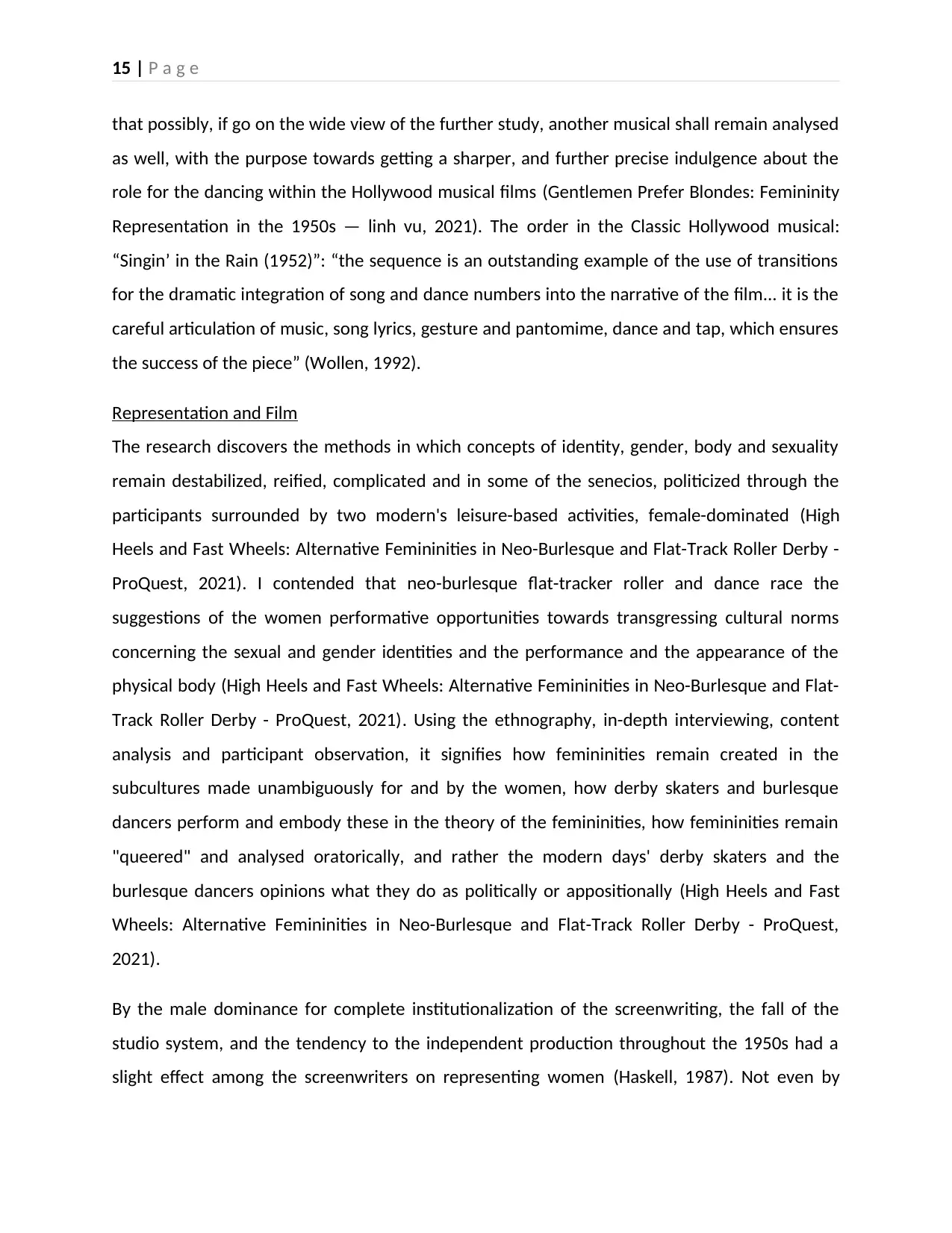
15 | P a g e
that possibly, if go on the wide view of the further study, another musical shall remain analysed
as well, with the purpose towards getting a sharper, and further precise indulgence about the
role for the dancing within the Hollywood musical films (Gentlemen Prefer Blondes: Femininity
Representation in the 1950s — linh vu, 2021). The order in the Classic Hollywood musical:
“Singin’ in the Rain (1952)”: “the sequence is an outstanding example of the use of transitions
for the dramatic integration of song and dance numbers into the narrative of the film... it is the
careful articulation of music, song lyrics, gesture and pantomime, dance and tap, which ensures
the success of the piece” (Wollen, 1992).
Representation and Film
The research discovers the methods in which concepts of identity, gender, body and sexuality
remain destabilized, reified, complicated and in some of the senecios, politicized through the
participants surrounded by two modern's leisure-based activities, female-dominated (High
Heels and Fast Wheels: Alternative Femininities in Neo-Burlesque and Flat-Track Roller Derby -
ProQuest, 2021). I contended that neo-burlesque flat-tracker roller and dance race the
suggestions of the women performative opportunities towards transgressing cultural norms
concerning the sexual and gender identities and the performance and the appearance of the
physical body (High Heels and Fast Wheels: Alternative Femininities in Neo-Burlesque and Flat-
Track Roller Derby - ProQuest, 2021). Using the ethnography, in-depth interviewing, content
analysis and participant observation, it signifies how femininities remain created in the
subcultures made unambiguously for and by the women, how derby skaters and burlesque
dancers perform and embody these in the theory of the femininities, how femininities remain
"queered" and analysed oratorically, and rather the modern days' derby skaters and the
burlesque dancers opinions what they do as politically or appositionally (High Heels and Fast
Wheels: Alternative Femininities in Neo-Burlesque and Flat-Track Roller Derby - ProQuest,
2021).
By the male dominance for complete institutionalization of the screenwriting, the fall of the
studio system, and the tendency to the independent production throughout the 1950s had a
slight effect among the screenwriters on representing women (Haskell, 1987). Not even by
that possibly, if go on the wide view of the further study, another musical shall remain analysed
as well, with the purpose towards getting a sharper, and further precise indulgence about the
role for the dancing within the Hollywood musical films (Gentlemen Prefer Blondes: Femininity
Representation in the 1950s — linh vu, 2021). The order in the Classic Hollywood musical:
“Singin’ in the Rain (1952)”: “the sequence is an outstanding example of the use of transitions
for the dramatic integration of song and dance numbers into the narrative of the film... it is the
careful articulation of music, song lyrics, gesture and pantomime, dance and tap, which ensures
the success of the piece” (Wollen, 1992).
Representation and Film
The research discovers the methods in which concepts of identity, gender, body and sexuality
remain destabilized, reified, complicated and in some of the senecios, politicized through the
participants surrounded by two modern's leisure-based activities, female-dominated (High
Heels and Fast Wheels: Alternative Femininities in Neo-Burlesque and Flat-Track Roller Derby -
ProQuest, 2021). I contended that neo-burlesque flat-tracker roller and dance race the
suggestions of the women performative opportunities towards transgressing cultural norms
concerning the sexual and gender identities and the performance and the appearance of the
physical body (High Heels and Fast Wheels: Alternative Femininities in Neo-Burlesque and Flat-
Track Roller Derby - ProQuest, 2021). Using the ethnography, in-depth interviewing, content
analysis and participant observation, it signifies how femininities remain created in the
subcultures made unambiguously for and by the women, how derby skaters and burlesque
dancers perform and embody these in the theory of the femininities, how femininities remain
"queered" and analysed oratorically, and rather the modern days' derby skaters and the
burlesque dancers opinions what they do as politically or appositionally (High Heels and Fast
Wheels: Alternative Femininities in Neo-Burlesque and Flat-Track Roller Derby - ProQuest,
2021).
By the male dominance for complete institutionalization of the screenwriting, the fall of the
studio system, and the tendency to the independent production throughout the 1950s had a
slight effect among the screenwriters on representing women (Haskell, 1987). Not even by
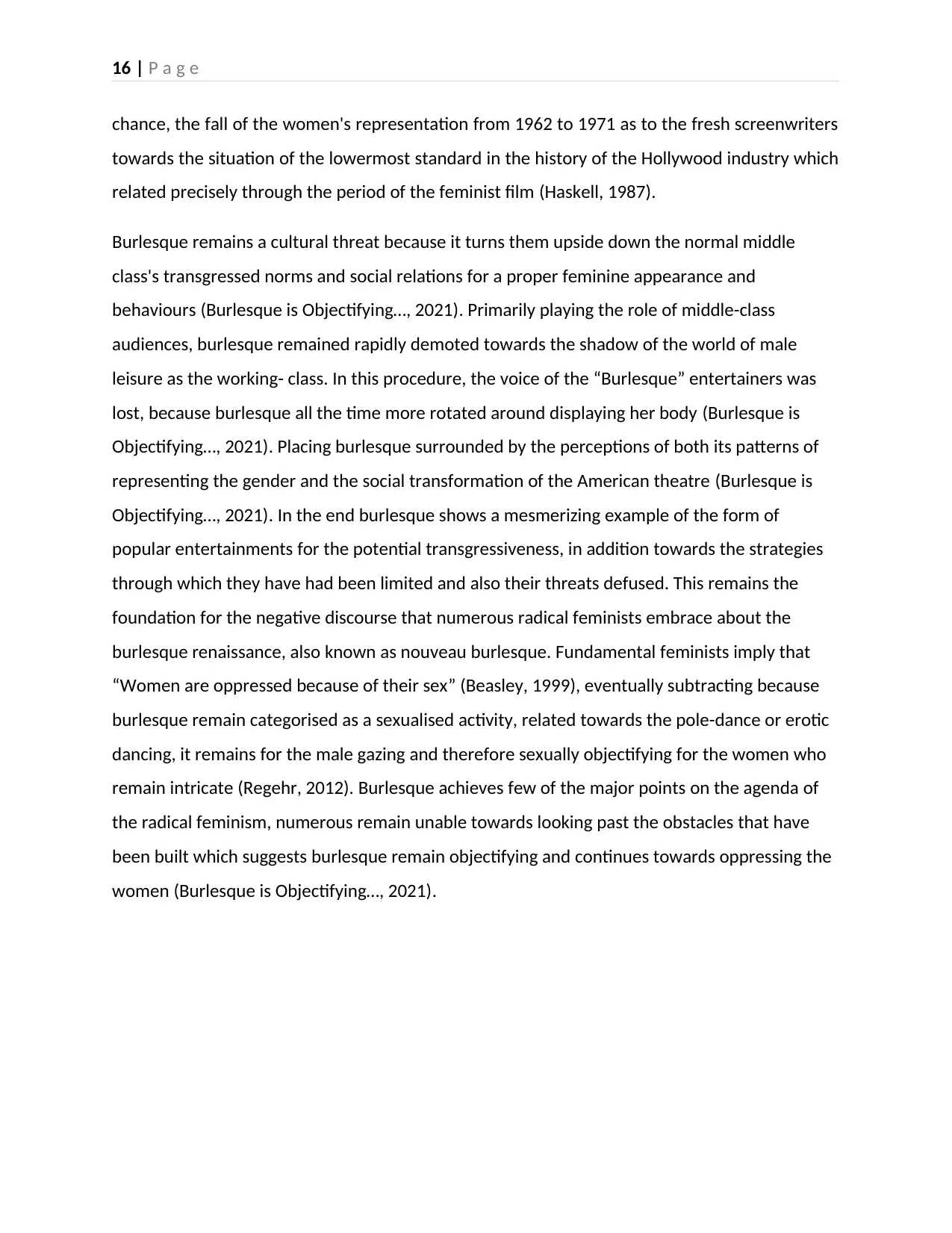
16 | P a g e
chance, the fall of the women's representation from 1962 to 1971 as to the fresh screenwriters
towards the situation of the lowermost standard in the history of the Hollywood industry which
related precisely through the period of the feminist film (Haskell, 1987).
Burlesque remains a cultural threat because it turns them upside down the normal middle
class's transgressed norms and social relations for a proper feminine appearance and
behaviours (Burlesque is Objectifying…, 2021). Primarily playing the role of middle-class
audiences, burlesque remained rapidly demoted towards the shadow of the world of male
leisure as the working- class. In this procedure, the voice of the “Burlesque” entertainers was
lost, because burlesque all the time more rotated around displaying her body (Burlesque is
Objectifying…, 2021). Placing burlesque surrounded by the perceptions of both its patterns of
representing the gender and the social transformation of the American theatre (Burlesque is
Objectifying…, 2021). In the end burlesque shows a mesmerizing example of the form of
popular entertainments for the potential transgressiveness, in addition towards the strategies
through which they have had been limited and also their threats defused. This remains the
foundation for the negative discourse that numerous radical feminists embrace about the
burlesque renaissance, also known as nouveau burlesque. Fundamental feminists imply that
“Women are oppressed because of their sex” (Beasley, 1999), eventually subtracting because
burlesque remain categorised as a sexualised activity, related towards the pole-dance or erotic
dancing, it remains for the male gazing and therefore sexually objectifying for the women who
remain intricate (Regehr, 2012). Burlesque achieves few of the major points on the agenda of
the radical feminism, numerous remain unable towards looking past the obstacles that have
been built which suggests burlesque remain objectifying and continues towards oppressing the
women (Burlesque is Objectifying…, 2021).
chance, the fall of the women's representation from 1962 to 1971 as to the fresh screenwriters
towards the situation of the lowermost standard in the history of the Hollywood industry which
related precisely through the period of the feminist film (Haskell, 1987).
Burlesque remains a cultural threat because it turns them upside down the normal middle
class's transgressed norms and social relations for a proper feminine appearance and
behaviours (Burlesque is Objectifying…, 2021). Primarily playing the role of middle-class
audiences, burlesque remained rapidly demoted towards the shadow of the world of male
leisure as the working- class. In this procedure, the voice of the “Burlesque” entertainers was
lost, because burlesque all the time more rotated around displaying her body (Burlesque is
Objectifying…, 2021). Placing burlesque surrounded by the perceptions of both its patterns of
representing the gender and the social transformation of the American theatre (Burlesque is
Objectifying…, 2021). In the end burlesque shows a mesmerizing example of the form of
popular entertainments for the potential transgressiveness, in addition towards the strategies
through which they have had been limited and also their threats defused. This remains the
foundation for the negative discourse that numerous radical feminists embrace about the
burlesque renaissance, also known as nouveau burlesque. Fundamental feminists imply that
“Women are oppressed because of their sex” (Beasley, 1999), eventually subtracting because
burlesque remain categorised as a sexualised activity, related towards the pole-dance or erotic
dancing, it remains for the male gazing and therefore sexually objectifying for the women who
remain intricate (Regehr, 2012). Burlesque achieves few of the major points on the agenda of
the radical feminism, numerous remain unable towards looking past the obstacles that have
been built which suggests burlesque remain objectifying and continues towards oppressing the
women (Burlesque is Objectifying…, 2021).
Secure Best Marks with AI Grader
Need help grading? Try our AI Grader for instant feedback on your assignments.
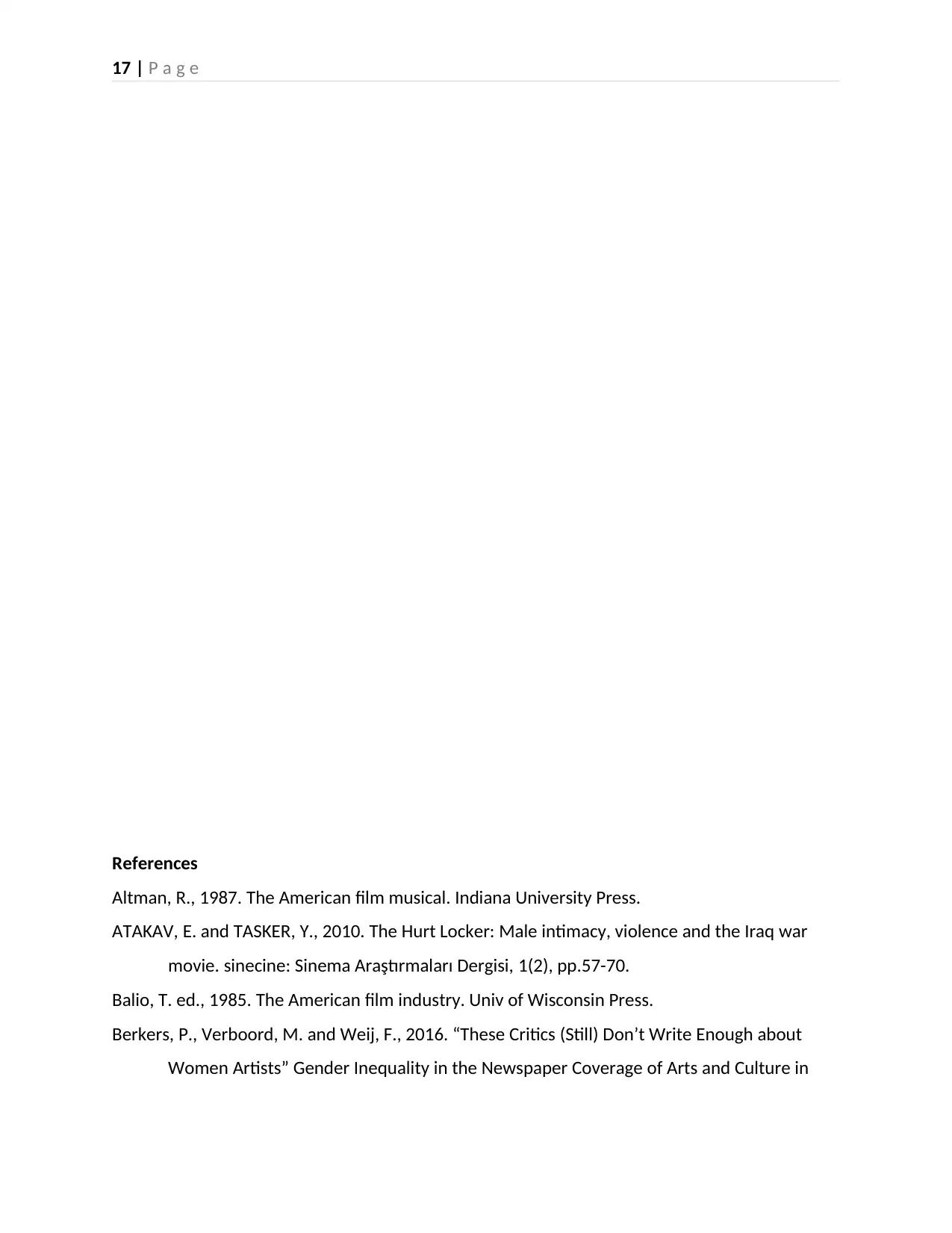
17 | P a g e
References
Altman, R., 1987. The American film musical. Indiana University Press.
ATAKAV, E. and TASKER, Y., 2010. The Hurt Locker: Male intimacy, violence and the Iraq war
movie. sinecine: Sinema Araştırmaları Dergisi, 1(2), pp.57-70.
Balio, T. ed., 1985. The American film industry. Univ of Wisconsin Press.
Berkers, P., Verboord, M. and Weij, F., 2016. “These Critics (Still) Don’t Write Enough about
Women Artists” Gender Inequality in the Newspaper Coverage of Arts and Culture in
References
Altman, R., 1987. The American film musical. Indiana University Press.
ATAKAV, E. and TASKER, Y., 2010. The Hurt Locker: Male intimacy, violence and the Iraq war
movie. sinecine: Sinema Araştırmaları Dergisi, 1(2), pp.57-70.
Balio, T. ed., 1985. The American film industry. Univ of Wisconsin Press.
Berkers, P., Verboord, M. and Weij, F., 2016. “These Critics (Still) Don’t Write Enough about
Women Artists” Gender Inequality in the Newspaper Coverage of Arts and Culture in
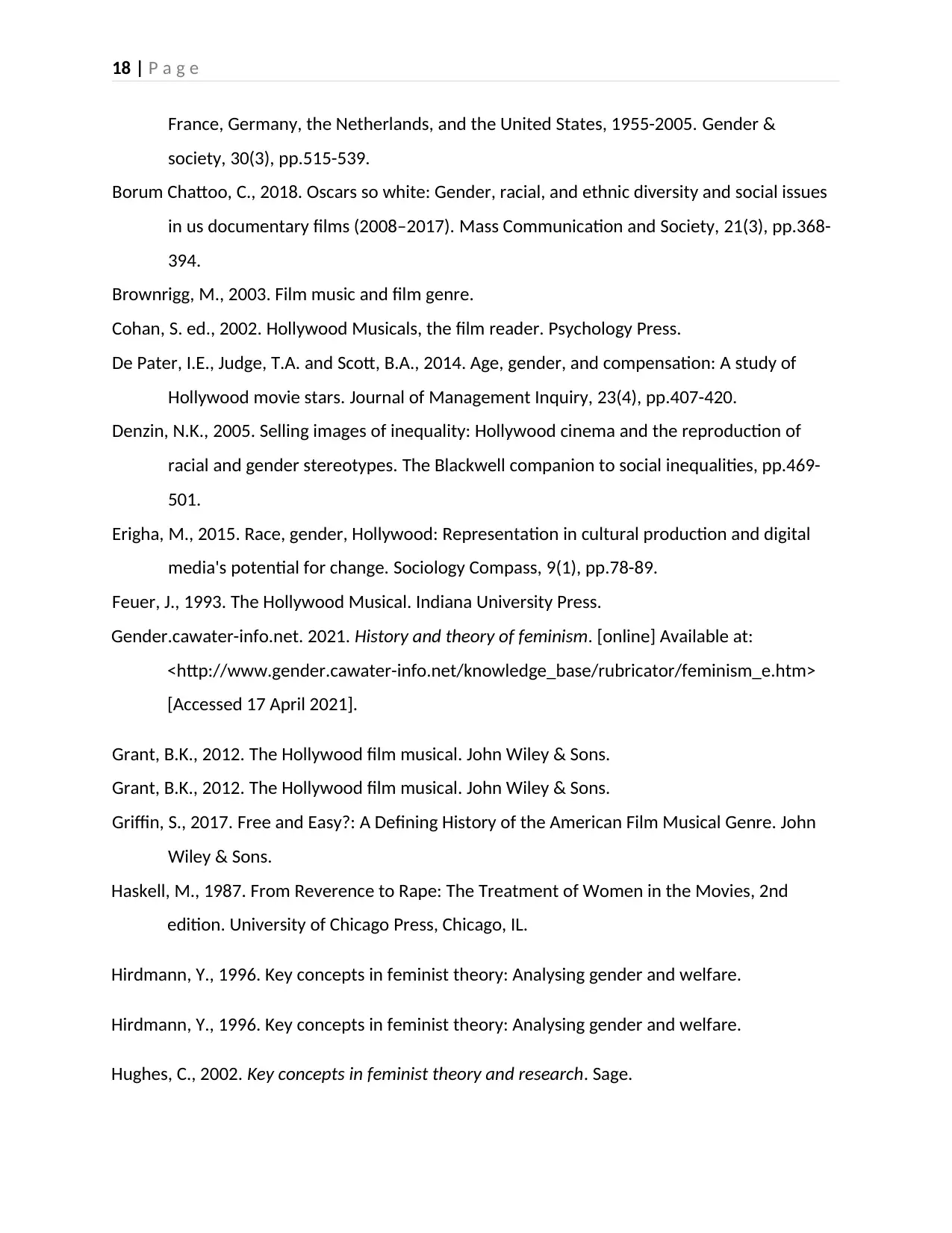
18 | P a g e
France, Germany, the Netherlands, and the United States, 1955-2005. Gender &
society, 30(3), pp.515-539.
Borum Chattoo, C., 2018. Oscars so white: Gender, racial, and ethnic diversity and social issues
in us documentary films (2008–2017). Mass Communication and Society, 21(3), pp.368-
394.
Brownrigg, M., 2003. Film music and film genre.
Cohan, S. ed., 2002. Hollywood Musicals, the film reader. Psychology Press.
De Pater, I.E., Judge, T.A. and Scott, B.A., 2014. Age, gender, and compensation: A study of
Hollywood movie stars. Journal of Management Inquiry, 23(4), pp.407-420.
Denzin, N.K., 2005. Selling images of inequality: Hollywood cinema and the reproduction of
racial and gender stereotypes. The Blackwell companion to social inequalities, pp.469-
501.
Erigha, M., 2015. Race, gender, Hollywood: Representation in cultural production and digital
media's potential for change. Sociology Compass, 9(1), pp.78-89.
Feuer, J., 1993. The Hollywood Musical. Indiana University Press.
Gender.cawater-info.net. 2021. History and theory of feminism. [online] Available at:
<http://www.gender.cawater-info.net/knowledge_base/rubricator/feminism_e.htm>
[Accessed 17 April 2021].
Grant, B.K., 2012. The Hollywood film musical. John Wiley & Sons.
Grant, B.K., 2012. The Hollywood film musical. John Wiley & Sons.
Griffin, S., 2017. Free and Easy?: A Defining History of the American Film Musical Genre. John
Wiley & Sons.
Haskell, M., 1987. From Reverence to Rape: The Treatment of Women in the Movies, 2nd
edition. University of Chicago Press, Chicago, IL.
Hirdmann, Y., 1996. Key concepts in feminist theory: Analysing gender and welfare.
Hirdmann, Y., 1996. Key concepts in feminist theory: Analysing gender and welfare.
Hughes, C., 2002. Key concepts in feminist theory and research. Sage.
France, Germany, the Netherlands, and the United States, 1955-2005. Gender &
society, 30(3), pp.515-539.
Borum Chattoo, C., 2018. Oscars so white: Gender, racial, and ethnic diversity and social issues
in us documentary films (2008–2017). Mass Communication and Society, 21(3), pp.368-
394.
Brownrigg, M., 2003. Film music and film genre.
Cohan, S. ed., 2002. Hollywood Musicals, the film reader. Psychology Press.
De Pater, I.E., Judge, T.A. and Scott, B.A., 2014. Age, gender, and compensation: A study of
Hollywood movie stars. Journal of Management Inquiry, 23(4), pp.407-420.
Denzin, N.K., 2005. Selling images of inequality: Hollywood cinema and the reproduction of
racial and gender stereotypes. The Blackwell companion to social inequalities, pp.469-
501.
Erigha, M., 2015. Race, gender, Hollywood: Representation in cultural production and digital
media's potential for change. Sociology Compass, 9(1), pp.78-89.
Feuer, J., 1993. The Hollywood Musical. Indiana University Press.
Gender.cawater-info.net. 2021. History and theory of feminism. [online] Available at:
<http://www.gender.cawater-info.net/knowledge_base/rubricator/feminism_e.htm>
[Accessed 17 April 2021].
Grant, B.K., 2012. The Hollywood film musical. John Wiley & Sons.
Grant, B.K., 2012. The Hollywood film musical. John Wiley & Sons.
Griffin, S., 2017. Free and Easy?: A Defining History of the American Film Musical Genre. John
Wiley & Sons.
Haskell, M., 1987. From Reverence to Rape: The Treatment of Women in the Movies, 2nd
edition. University of Chicago Press, Chicago, IL.
Hirdmann, Y., 1996. Key concepts in feminist theory: Analysing gender and welfare.
Hirdmann, Y., 1996. Key concepts in feminist theory: Analysing gender and welfare.
Hughes, C., 2002. Key concepts in feminist theory and research. Sage.
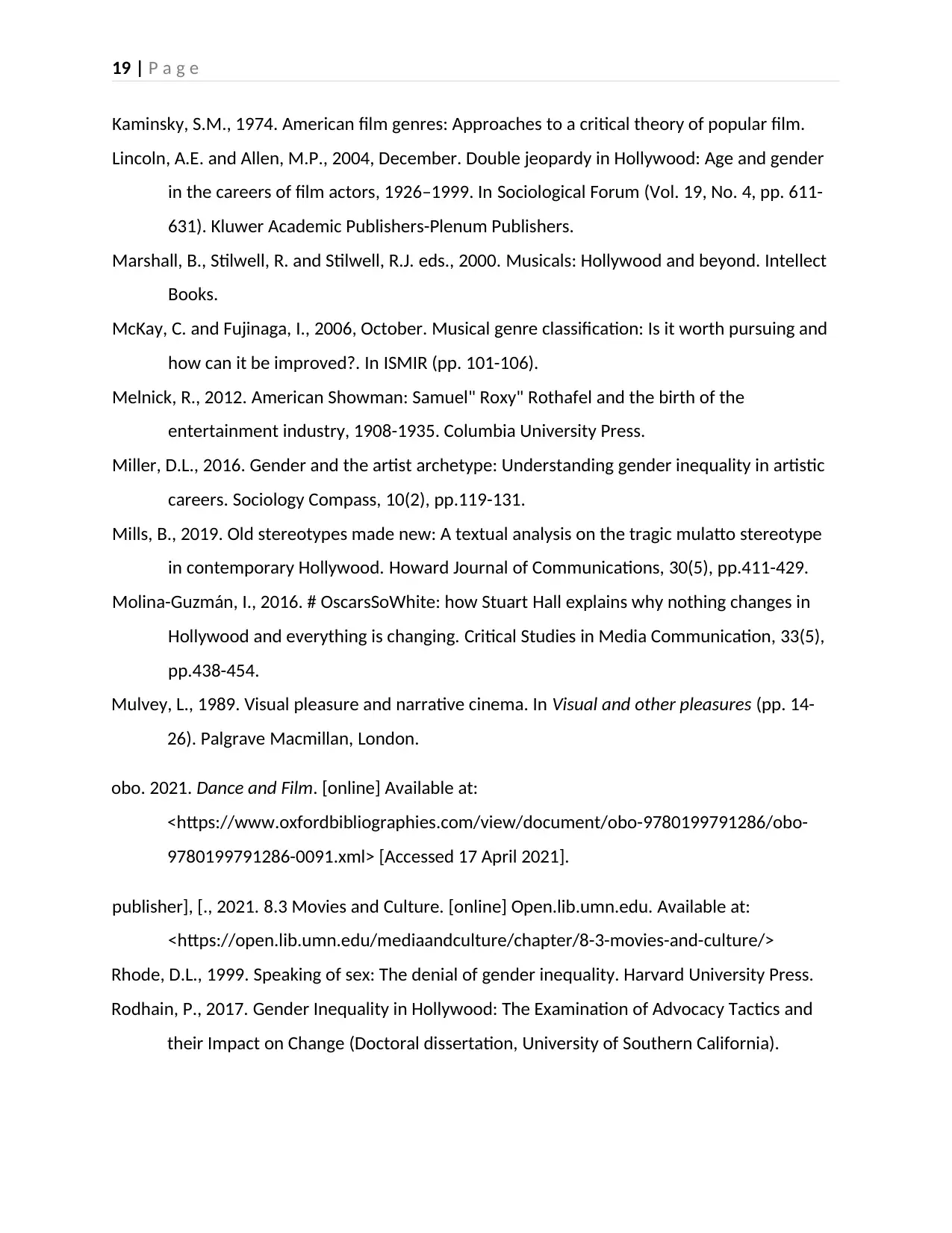
19 | P a g e
Kaminsky, S.M., 1974. American film genres: Approaches to a critical theory of popular film.
Lincoln, A.E. and Allen, M.P., 2004, December. Double jeopardy in Hollywood: Age and gender
in the careers of film actors, 1926–1999. In Sociological Forum (Vol. 19, No. 4, pp. 611-
631). Kluwer Academic Publishers-Plenum Publishers.
Marshall, B., Stilwell, R. and Stilwell, R.J. eds., 2000. Musicals: Hollywood and beyond. Intellect
Books.
McKay, C. and Fujinaga, I., 2006, October. Musical genre classification: Is it worth pursuing and
how can it be improved?. In ISMIR (pp. 101-106).
Melnick, R., 2012. American Showman: Samuel" Roxy" Rothafel and the birth of the
entertainment industry, 1908-1935. Columbia University Press.
Miller, D.L., 2016. Gender and the artist archetype: Understanding gender inequality in artistic
careers. Sociology Compass, 10(2), pp.119-131.
Mills, B., 2019. Old stereotypes made new: A textual analysis on the tragic mulatto stereotype
in contemporary Hollywood. Howard Journal of Communications, 30(5), pp.411-429.
Molina-Guzmán, I., 2016. # OscarsSoWhite: how Stuart Hall explains why nothing changes in
Hollywood and everything is changing. Critical Studies in Media Communication, 33(5),
pp.438-454.
Mulvey, L., 1989. Visual pleasure and narrative cinema. In Visual and other pleasures (pp. 14-
26). Palgrave Macmillan, London.
obo. 2021. Dance and Film. [online] Available at:
<https://www.oxfordbibliographies.com/view/document/obo-9780199791286/obo-
9780199791286-0091.xml> [Accessed 17 April 2021].
publisher], [., 2021. 8.3 Movies and Culture. [online] Open.lib.umn.edu. Available at:
<https://open.lib.umn.edu/mediaandculture/chapter/8-3-movies-and-culture/>
Rhode, D.L., 1999. Speaking of sex: The denial of gender inequality. Harvard University Press.
Rodhain, P., 2017. Gender Inequality in Hollywood: The Examination of Advocacy Tactics and
their Impact on Change (Doctoral dissertation, University of Southern California).
Kaminsky, S.M., 1974. American film genres: Approaches to a critical theory of popular film.
Lincoln, A.E. and Allen, M.P., 2004, December. Double jeopardy in Hollywood: Age and gender
in the careers of film actors, 1926–1999. In Sociological Forum (Vol. 19, No. 4, pp. 611-
631). Kluwer Academic Publishers-Plenum Publishers.
Marshall, B., Stilwell, R. and Stilwell, R.J. eds., 2000. Musicals: Hollywood and beyond. Intellect
Books.
McKay, C. and Fujinaga, I., 2006, October. Musical genre classification: Is it worth pursuing and
how can it be improved?. In ISMIR (pp. 101-106).
Melnick, R., 2012. American Showman: Samuel" Roxy" Rothafel and the birth of the
entertainment industry, 1908-1935. Columbia University Press.
Miller, D.L., 2016. Gender and the artist archetype: Understanding gender inequality in artistic
careers. Sociology Compass, 10(2), pp.119-131.
Mills, B., 2019. Old stereotypes made new: A textual analysis on the tragic mulatto stereotype
in contemporary Hollywood. Howard Journal of Communications, 30(5), pp.411-429.
Molina-Guzmán, I., 2016. # OscarsSoWhite: how Stuart Hall explains why nothing changes in
Hollywood and everything is changing. Critical Studies in Media Communication, 33(5),
pp.438-454.
Mulvey, L., 1989. Visual pleasure and narrative cinema. In Visual and other pleasures (pp. 14-
26). Palgrave Macmillan, London.
obo. 2021. Dance and Film. [online] Available at:
<https://www.oxfordbibliographies.com/view/document/obo-9780199791286/obo-
9780199791286-0091.xml> [Accessed 17 April 2021].
publisher], [., 2021. 8.3 Movies and Culture. [online] Open.lib.umn.edu. Available at:
<https://open.lib.umn.edu/mediaandculture/chapter/8-3-movies-and-culture/>
Rhode, D.L., 1999. Speaking of sex: The denial of gender inequality. Harvard University Press.
Rodhain, P., 2017. Gender Inequality in Hollywood: The Examination of Advocacy Tactics and
their Impact on Change (Doctoral dissertation, University of Southern California).
Paraphrase This Document
Need a fresh take? Get an instant paraphrase of this document with our AI Paraphraser
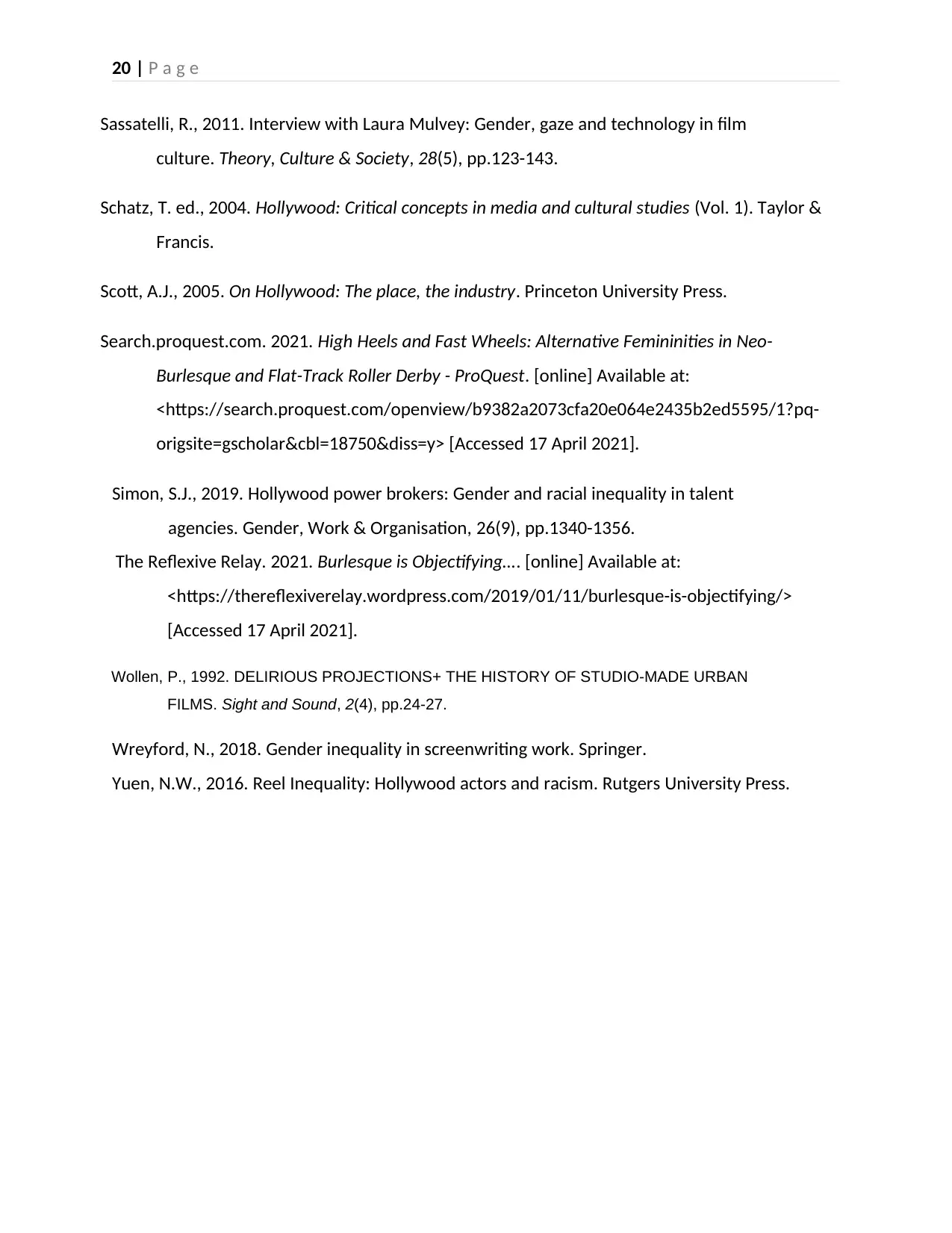
20 | P a g e
Sassatelli, R., 2011. Interview with Laura Mulvey: Gender, gaze and technology in film
culture. Theory, Culture & Society, 28(5), pp.123-143.
Schatz, T. ed., 2004. Hollywood: Critical concepts in media and cultural studies (Vol. 1). Taylor &
Francis.
Scott, A.J., 2005. On Hollywood: The place, the industry. Princeton University Press.
Search.proquest.com. 2021. High Heels and Fast Wheels: Alternative Femininities in Neo-
Burlesque and Flat-Track Roller Derby - ProQuest. [online] Available at:
<https://search.proquest.com/openview/b9382a2073cfa20e064e2435b2ed5595/1?pq-
origsite=gscholar&cbl=18750&diss=y> [Accessed 17 April 2021].
Simon, S.J., 2019. Hollywood power brokers: Gender and racial inequality in talent
agencies. Gender, Work & Organisation, 26(9), pp.1340-1356.
The Reflexive Relay. 2021. Burlesque is Objectifying…. [online] Available at:
<https://thereflexiverelay.wordpress.com/2019/01/11/burlesque-is-objectifying/>
[Accessed 17 April 2021].
Wollen, P., 1992. DELIRIOUS PROJECTIONS+ THE HISTORY OF STUDIO-MADE URBAN
FILMS. Sight and Sound, 2(4), pp.24-27.
Wreyford, N., 2018. Gender inequality in screenwriting work. Springer.
Yuen, N.W., 2016. Reel Inequality: Hollywood actors and racism. Rutgers University Press.
Sassatelli, R., 2011. Interview with Laura Mulvey: Gender, gaze and technology in film
culture. Theory, Culture & Society, 28(5), pp.123-143.
Schatz, T. ed., 2004. Hollywood: Critical concepts in media and cultural studies (Vol. 1). Taylor &
Francis.
Scott, A.J., 2005. On Hollywood: The place, the industry. Princeton University Press.
Search.proquest.com. 2021. High Heels and Fast Wheels: Alternative Femininities in Neo-
Burlesque and Flat-Track Roller Derby - ProQuest. [online] Available at:
<https://search.proquest.com/openview/b9382a2073cfa20e064e2435b2ed5595/1?pq-
origsite=gscholar&cbl=18750&diss=y> [Accessed 17 April 2021].
Simon, S.J., 2019. Hollywood power brokers: Gender and racial inequality in talent
agencies. Gender, Work & Organisation, 26(9), pp.1340-1356.
The Reflexive Relay. 2021. Burlesque is Objectifying…. [online] Available at:
<https://thereflexiverelay.wordpress.com/2019/01/11/burlesque-is-objectifying/>
[Accessed 17 April 2021].
Wollen, P., 1992. DELIRIOUS PROJECTIONS+ THE HISTORY OF STUDIO-MADE URBAN
FILMS. Sight and Sound, 2(4), pp.24-27.
Wreyford, N., 2018. Gender inequality in screenwriting work. Springer.
Yuen, N.W., 2016. Reel Inequality: Hollywood actors and racism. Rutgers University Press.

21 | P a g e
1 out of 21
Your All-in-One AI-Powered Toolkit for Academic Success.
+13062052269
info@desklib.com
Available 24*7 on WhatsApp / Email
![[object Object]](/_next/static/media/star-bottom.7253800d.svg)
Unlock your academic potential
© 2024 | Zucol Services PVT LTD | All rights reserved.